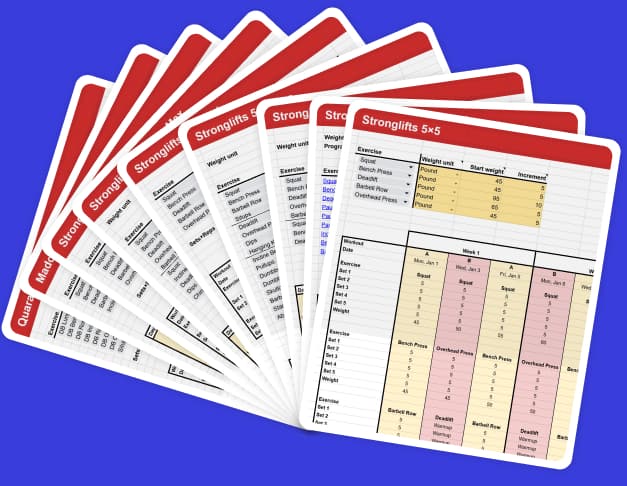Stronglifts 5×5 Intermediate is a strength and muscle building program for lifters who are past the easy beginner gains.
- You know how to Squat, Bench and Deadlift with proper form.
- You’ve been stuck at the same weight on several lifts for weeks.
- You want to keep building strength and muscle by training 3x/week.
Stronglifts 5×5 Intermediate helps you break through the plateaus that you’ve reached on Stronglifts 5×5. It helps you lift more weight and increase your muscle size. It does this using three simple workouts every week.
Stronglifts 5×5 Intermediate builds on Stronglifts 5×5. It uses similar workouts but introduces exercise variations to help you progress again. The Stronglifts app fully supports the program which makes the transition easy. This is the best training program you can do after Stronglifts 5×5.
In this guide I’ll show you how Stronglifts 5×5 Intermediate works, why it works so well for breaking plateaus, and how to get started.
Contents
- Introduction
- Workouts and exercises
- Sets & Reps
- Volume
- Frequently asked questions
- When should you switch from Stronglifts 5×5 to Stronglifts 5×5 Intermediate?
- How much should you lift before switching to Stronglifts 5×5 Intermediate?
- Which variation of Stronglifts 5×5 Intermediate should you start with?
- Should you do straight sets or top/back-off sets?
- Why only two Deadlift sets in workout C?
- Are seven sets of Deadlifts per week enough?
- Isn’t 3x/week Bench Press too much?
- Isn’t 20 sets per week on Bench too much?
- Shouldn’t you do a 1:1 ratio Bench, Overhead Press and Row?
- Is there a spreadsheet for Stronglifts 5×5 Intermediate?
- References
Join the Stronglifts community to get free access to all the spreadsheets for every Stronglifts program. You’ll also get daily email tips to stay motivated. Enter your email below to sign up today for free.
Introduction
What is Stronglifts 5×5 Intermediate
Stronglifts 5×5 Intermediate is a strength and muscle building program for lifters who are past the easy beginner gains. You do compound lifts like the Squat, Bench and Deadlift for five sets of five reps (5×5). Your goal is to complete your sets with good form and add weight over time.
Each week you do three workouts A, B and C. At least one rest day between two workouts is recommended for recovery. The most common schedule is Monday, Wednesday and Friday. Like this…
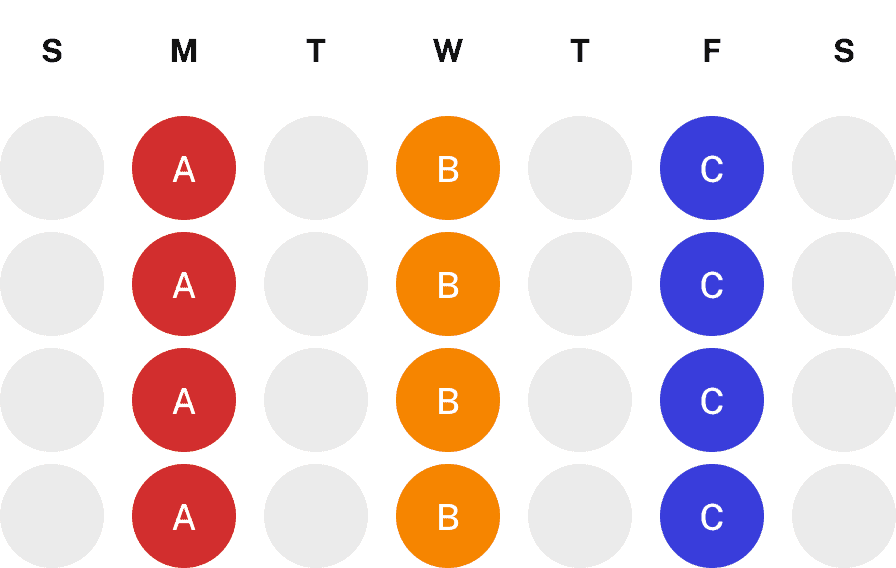
It’s possible to do two workouts in a row on Stronglifts 5×5 Intermediate. This is because each workout has different exercises that progress independently. So you could train Monday, Tuesday, Friday if needed.
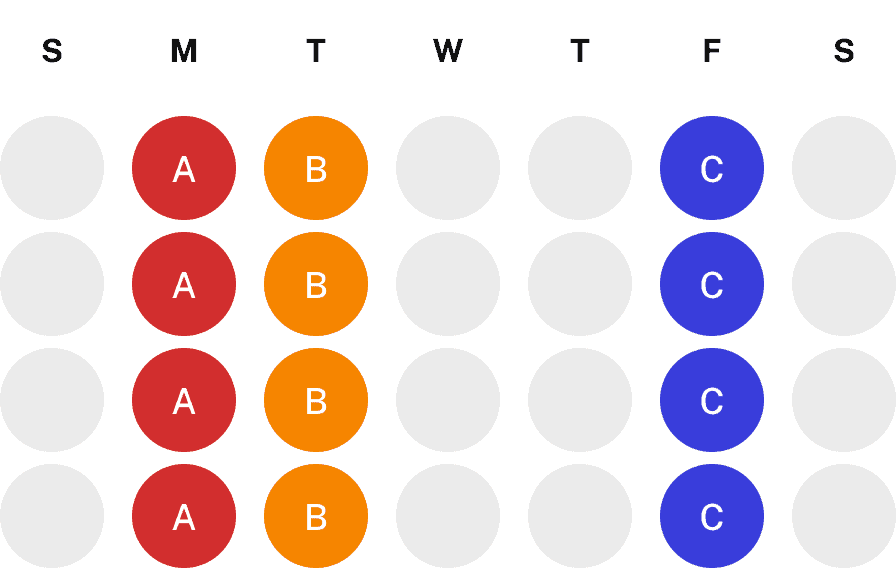
There are several variations of Stronglifts 5×5 Intermediate that I’ll show you in this guide. This is the default template that I recommend for lifters who are no longer making progress on Stronglifts 5×5 or want a change.
| Stronglifts 5×5 Intermediate | ||
|---|---|---|
| Workout A | Workout B | Workout C |
| Squat 5×5 | Deadlift 5×5 | Pause Squat 5×3 |
| Bench Press 5×5 | Incline Bench Press 5×8 | Pause Bench 5×3 |
| Barbell Rows 5×8 | Bench Press Feet up 5×8 | Pause Deadlift 2×3 |
| Assistance work | Assistance work | Assistance work |
Stronglifts 5×5 Intermediate can be extended with assistance work as explained below. You can choose from several program templates based on your likes and needs, or to get a change after a few weeks.
The Stronglifts app supports Stronglifts 5×5 Intermediate. Download the app, then go to program – select Stronglifts 5×5 Intermediate. Pick the template and assistance. Everything will be setup for you.
Who is Stronglifts 5×5 Intermediate for
Stronglifts 5×5 Intermediate is for lifters who want to build strength and muscle but who are beyond the easy beginner gains. It’s specifically designed for Stronglifters who are no longer making progress with Stronglifts 5×5.
- You already know how to Squat, Bench and Deadlift with good form. You know how to balance the bar. You know the proper grip and stance. You’ve mastered the basics and lift decent weights.
- You can no longer add weight several times a week on the same lift. You’re failing reps despite good nutrition, recovery, technique, and effort. You’ve hit a plateau despite switching to 5×5 top/back-off sets. You’ve progressed past the easy beginner gains.
- Squatting 3x/week has become too much. You’re lifting heavier weights than when you started and this has doubled or even tripled your Squat volume. You feel like you’re not recovering fast enough.
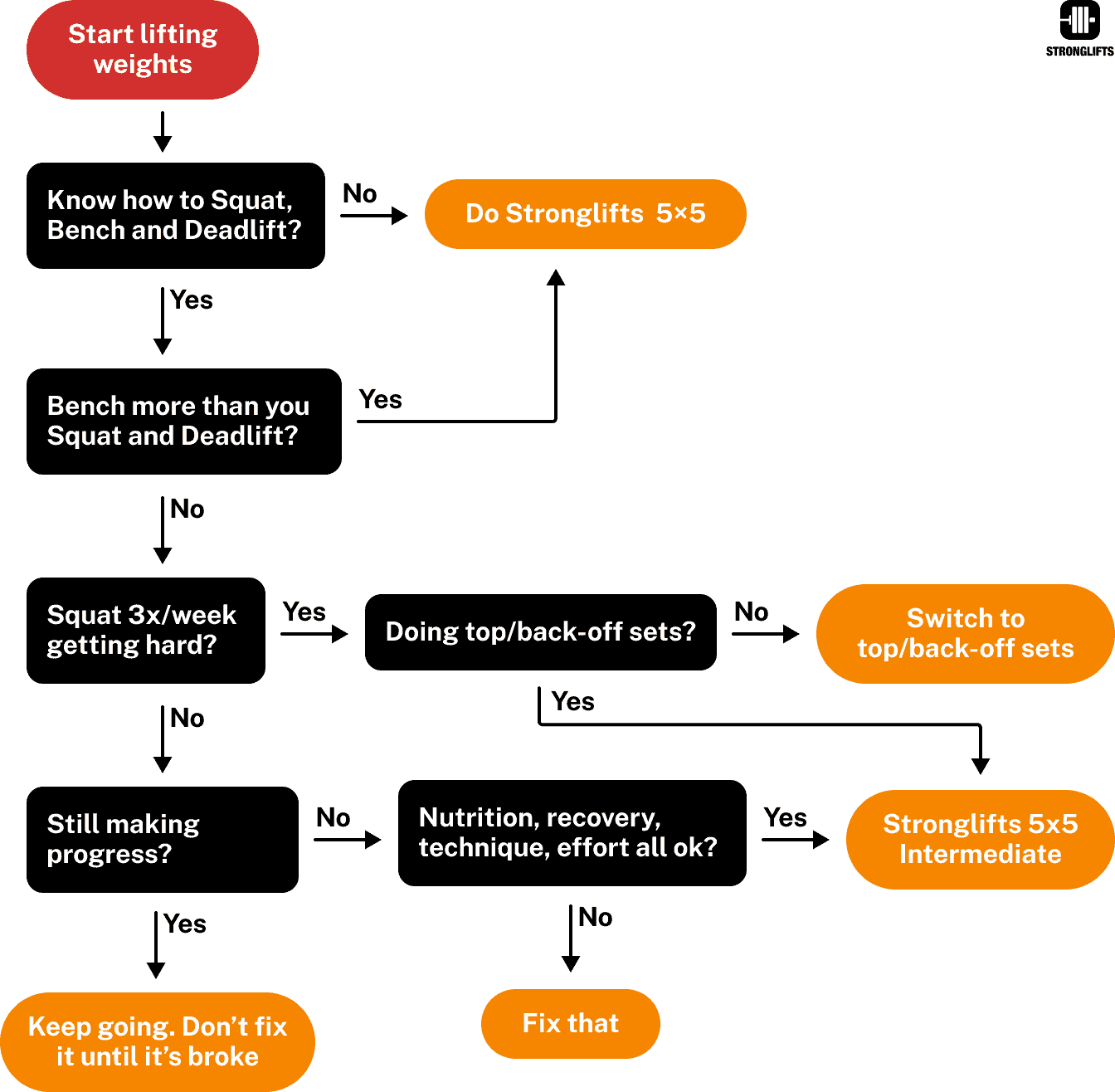
The program will help you to break through plateaus that you’ve hit on Stronglifts 5×5. It will also challenge your technique with various new exercises. This will help you to improve your form further.
Stronglifts 5×5 Intermediate is not for new or weaker lifters. It’s not for lifters who don’t know how to Squat, Bench Press and Deadlift yet. It’s not for lifters who Bench Press the same weight they Squat and Deadlift.
Don’t jump on this program because it’s more “advanced” than Stronglifts 5×5. If you’ve never done a structured program focused on compound lifts and progressive overload, you can still experience easy beginner gains despite going to the gym for a decade. In this case, you’ll actually progress faster with Stronglifts 5×5. Do that program first, then come back to this.
Why Stronglifts 5×5 Intermediate works
Stronglifts 5×5 Intermediate works for the same reasons Stronglifts 5×5 works. It centers around the fundamental principles of strength and muscle building (1). You do mostly compound lifts, use proper technique, train consistently, and apply progressive overload by adding weight over time.
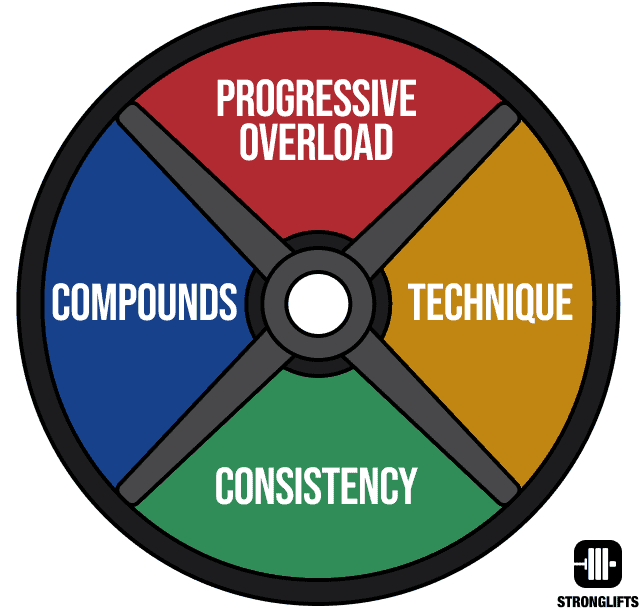
Stronglifts 5×5 Intermediate has a similar workout structure and progression logic as Stronglifts 5×5. But there are several important differences…
- You Squat 2x/week instead of 3x. This slows down your progression now that you’re lifting heavier weights and are more skilled.
- You Deadlift 2x/week, including 1x/week for 5×5. This is possible now that you’re Squatting 2x/week. It gives you more Deadlift practice.
- You Bench 3x/week instead of 1.5x/week. The extra volume helps you break through plateaus and increases your chest size further.
- You do exercise variations. This helps you further improve your form, prevents boredom, and helps you break plateaus (2).
Your body needs these program changes because it’s different after doing Stronglifts 5×5. You’re stronger, more muscular and have better form. The easy beginner gains are over. Progress will be slower from now on (3). Your training program has to change because your body has changed too.
The best way to understand why Stronglifts 5×5 Intermediate works is to read how to break plateaus on Stronglifts 5×5. This guide explains why Stronglifts works, why it eventually stops working, and how your training program needs to change to make progress again. Stronglifts 5×5 Intermediate implements all the necessary changes described in that guide.
Origins of Stronglifts 5×5 Intermediate
Stronglifts 5×5 Intermediate is influenced by the teachings of my coach Mike Tuchscherer and my experience coaching Stronglifters.
Mike Tuchscherer is a competitive powerlifter with 20 years of experience (4). He broke world records, won gold medals, and coached world champions like Brett Gibbs and Dennis Cornelius. Mike is best known for introducing RPE (rate of perceived effort) to the lifting world in 2008 (5).
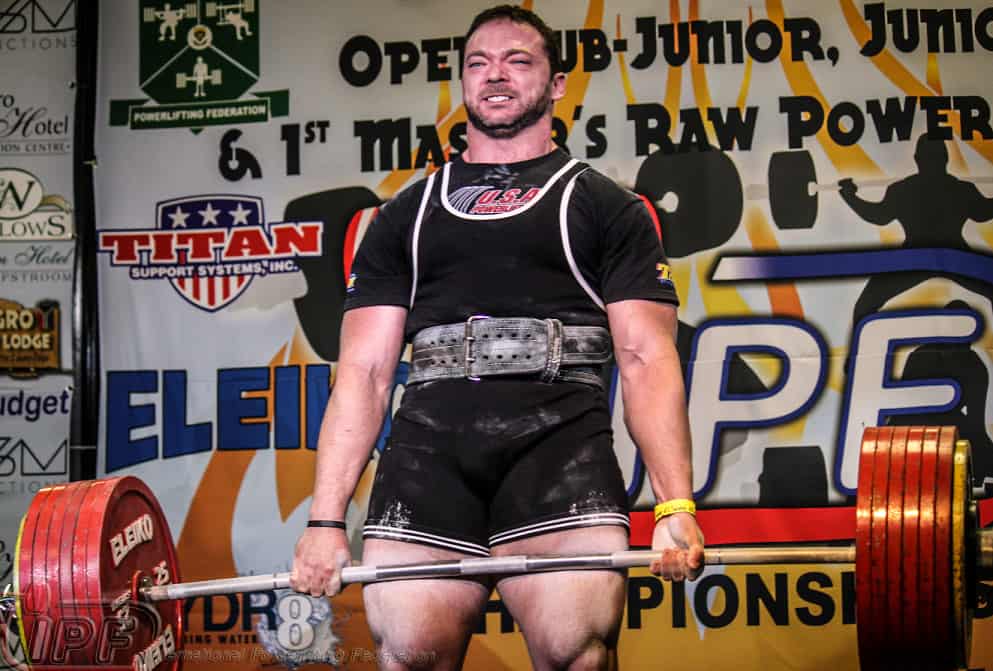
In November 2011, Mike Tuchscherer became my coach. Back then you’d often see people yell and toss things around before lifting heavy. I’m a calm lifter so I never liked that. It seemed like a waste of energy. One day I saw Mike Squatting 925lb. I had never seen someone Squat that much weight, all alone, in their garage. Plus he didn’t make a noise. I trained alone in my garage too so I liked that. He seemed like me – just a lot stronger.
I read Mike’s book. It wasn’t the usual “shut up and lift”. He took a methodical approach to lifting. This really resonated with me. My Squat was about 380lb back then and I was struggling to get stronger. I knew that most competitive lifters have coaches (6). When I started lifting I had a mentor but I never had an actual coach. I contacted Mike for coaching and he accepted.
Mike Tuchscherer coached me for more than 10 years. All my lifts increased and I set new personal records. I learned to write good programs by watching him create mine, completing all his programming courses, and asking lots of questions. We met many times in the USA and Europe where I trained with him. We kept in touch with regular phone calls where we talked a lot about lifting. At first he was just my coach but he became a mentor and good friend. He really changed the way I thought about lifting.

The result was that I started to apply everything I had learned when writing programs for clients I was coaching 1on1. It became my favorite thing to do. Over the years I wrote many, many programs. Still do. However because my usual clients have different needs and goals from Mike’s, the programs I created looked different from what he usually made for me.
Stronglifts 5×5 Intermediate combines everything that I learned from Mike with my experience coaching Stronglifters who are no longer making progress on Stronglifts 5×5 once they’re past the beginner gains.
It’s fully supported by the Stronglifts app. Just go to program – select Stronglifts 5×5 Intermediate. Everything will be setup for you.
Workouts and exercises
Workout A
The workout A of Stronglifts 5×5 Intermediate is similar to the one of Stronglifts 5×5. You Squat, Bench Press and Barbell Row for five sets each.
| Stronglifts 5×5 Intermediate | Stronglifts 5×5 |
|---|---|
| Workout A | Workout A |
| Squat 5×5 | Squat 5×5 |
| Bench Press 5×5 | Bench Press 5×5 |
| Barbell Row 5×8 | Barbell Row 5×5 |
| Assistance work | Assistance work |
The only difference is that you’re doing five sets of eight reps (5×8) on Barbell Rows instead of 5×5. I’ll explain why in the sets & reps section below.
Workout A is a full body workout – you train your upper and lower body on the same day. It’s also a push pull leg day. You Squat first (legs) then Bench Press (push upper-body) and finish with Rows (pull upper-body).
| Workout A | Movement | Muscle worked |
|---|---|---|
| Squat 5×5 | Knee bend | Legs |
| Bench Press 5×5 | Horizontal Push | Chest, shoulders, triceps |
| Barbell Rows 5×8 | Horizontal pull | Upper-back, biceps |
The Squat and Bench are two of the most important exercises. We do them at the start of the week after two days rest, when you’re well-rested. This helps you put more effort and focus into these exercises so you progress better. If you miss later workouts that week, you still worked the main muscles of your lower and upper body with workout A.
Workout B
The workout B of Stronglifts 5×5 Intermediate is quite different from the one in Stronglifts 5×5. Deadlifts are now the first exercise. The Squat and Overhead press are replaced by two Bench Press exercises.
| Stronglifts 5×5 Intermediate | Stronglifts 5×5 |
|---|---|
| Workout B | Workout B |
| Deadlift 5×5 | Squat 5×5 |
| Incline Bench Press 5×8 | Overhead Press 5×5 |
| Bench Press Feet up 5×8 | Deadlift 1×5 |
| Assistance work | Assistance work |
You now do Deadlifts for 5×5 instead of 1×5. This wasn’t recommended on Stronglifts 5×5 but it’s now possible on Stronglifts 5×5 Intermediate due to the lower Squat frequency. I’ll explain this in the sets & reps section below.
5×5 Deadlift is not easy. The Deadlift works the most amount of muscles – not just your legs but also your upper body. It’s the exercise where you can lift the most amount of weight. And so we start workout B with 5×5 Deadlifts. We do it first when you’re freshest and have the most energy. This helps you train the lift harder so you progress better.
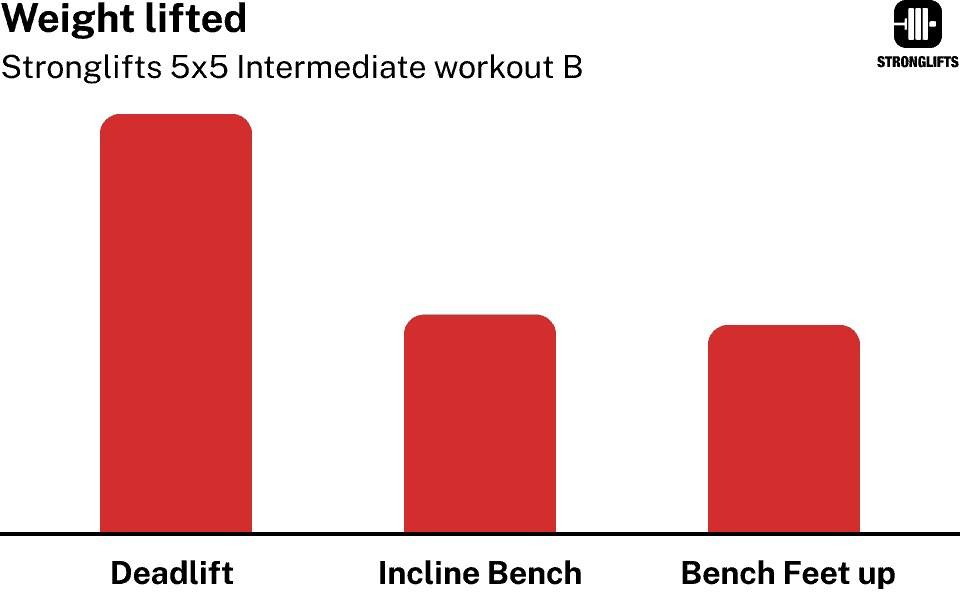
After Deadlifts you do two bench exercises. The bench works less and smaller muscles. This limits how heavy you can go. Doing bench variations and high reps further limit the weight. While workout B starts hard, it becomes easier. It’s actually a “light” day for your chest in terms of weight lifted.
| Workout B | Movement | Muscle worked |
|---|---|---|
| Deadlift 5×5 | Hip Hinge | Legs, back |
| Incline Bench Press 5×8 | Horizontal Push | Chest, shoulders, triceps |
| Bench Press Feet up 5×8 | Horizontal Push | Chest, shoulders, triceps |
Workout B is another full body workout – you train your upper and lower body on the same day. You start with legs and back, then do chest, shoulders and triceps. Expect pump from doing 10 high rep sets for your upper-body. I’ll explain in the sets & rep section why you do 5×8 on the bench lifts.
Incline Bench
The Incline Bench is a Bench Press done on a 30-degree incline bench. If you don’t have an incline bench like me, you can stack plates under the back leg.
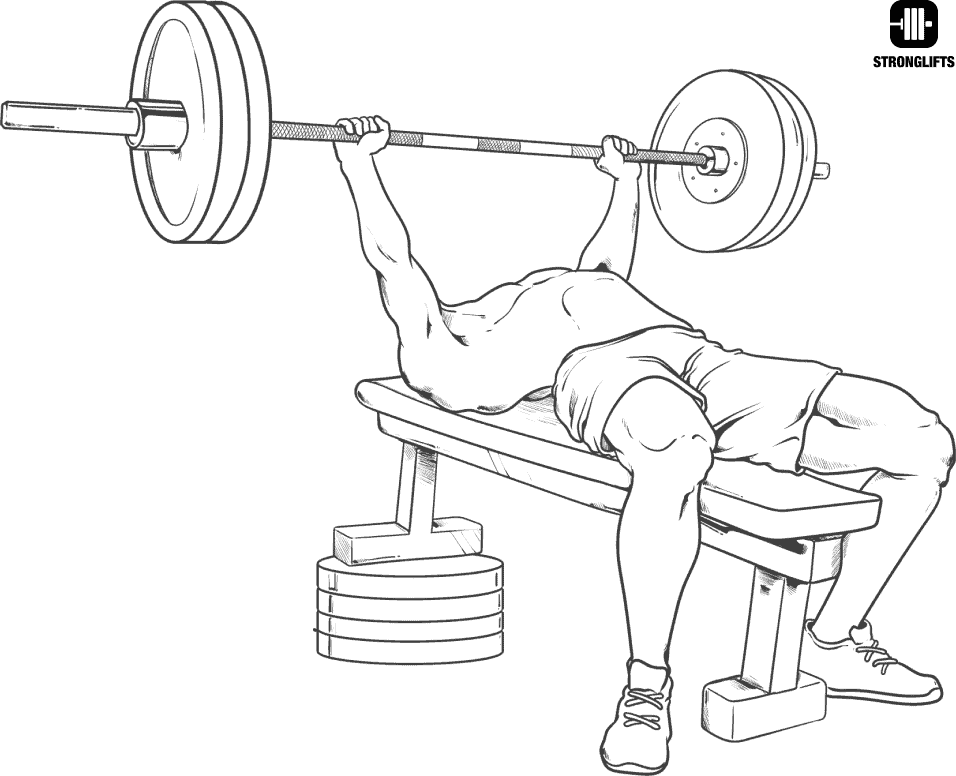
The Incline Bench Press replaces the Overhead Press you did in workout B of Stronglifts 5×5. While the Overhead Press can be fun, the strength gains don’t carry-over well to the Bench Press. All three exercises involve pressing weight away from you but the movements are quite different. Compare…
- You Overhead Press while standing
- You Bench Press while lying on a Bench
- You Incline Bench while lying on a slightly inclined bench
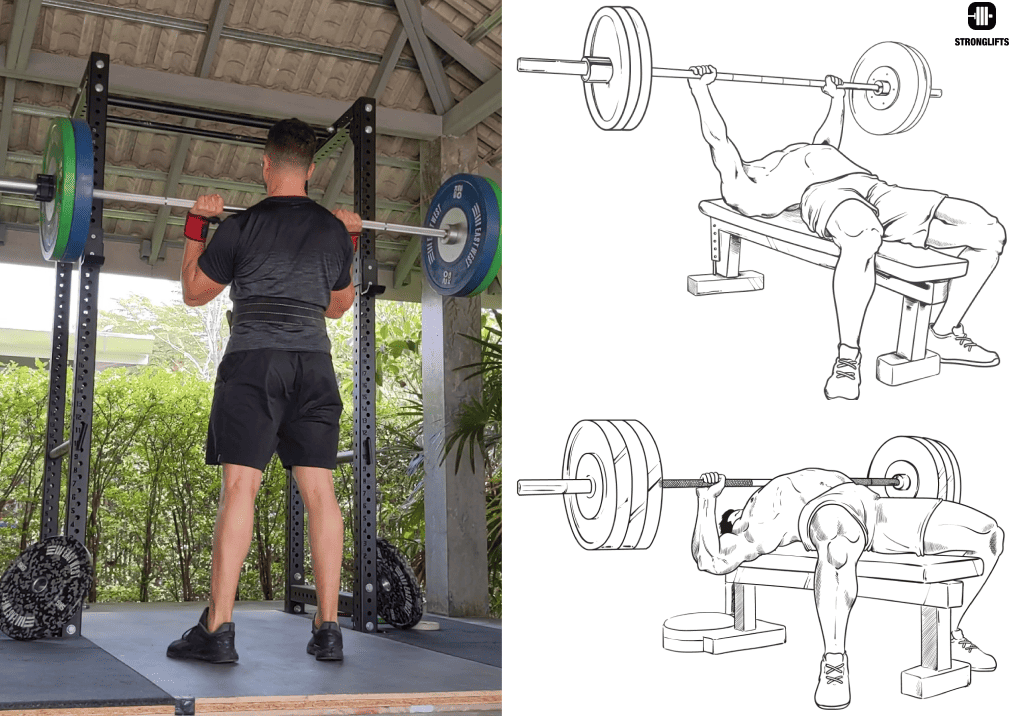
The Incline Bench movement is more similar to the Bench Press. The strength gains therefore better transfer to the Bench Press. This is the fundamental training principle of specificity (1). To increase your Bench Press you need to do the Bench Press and close variations that mimic the movement.

Benching incline can improve your technique for the flat bench by teaching you to press the bar back on the way up (7). Less experienced lifters often make the mistake of pressing the bar up in a vertical line. This is ineffective because it moves the bar away from your shoulders. The more effective way to Bench Press is to push the bar back towards your head and shoulders after it leaves your chest (7, 8, 9).
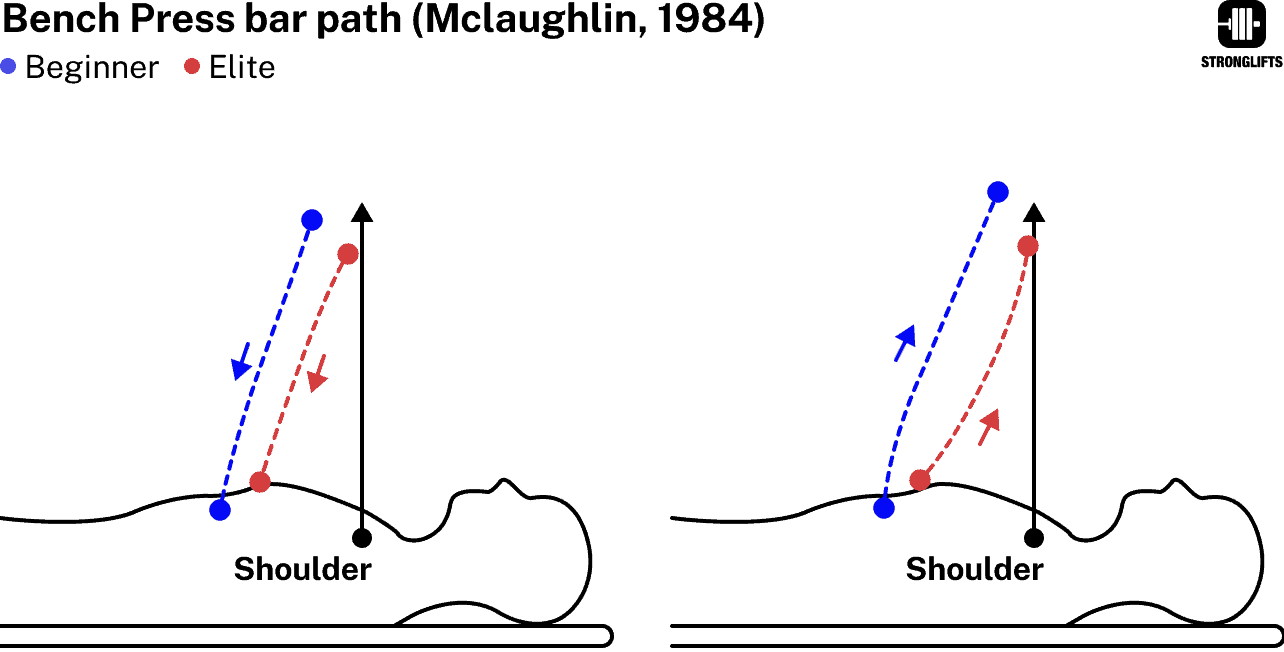
The proper bar path on the Bench Press is diagonal. The bar path on the Incline Bench Press is even more diagonal because your body is slanted. If you press the bar straight up like you might do by mistake on the flat bench, you’ll immediately notice that it’s too hard. Benching incline encourages a diagonal bar movement which transfers to a better path on the flat bench.
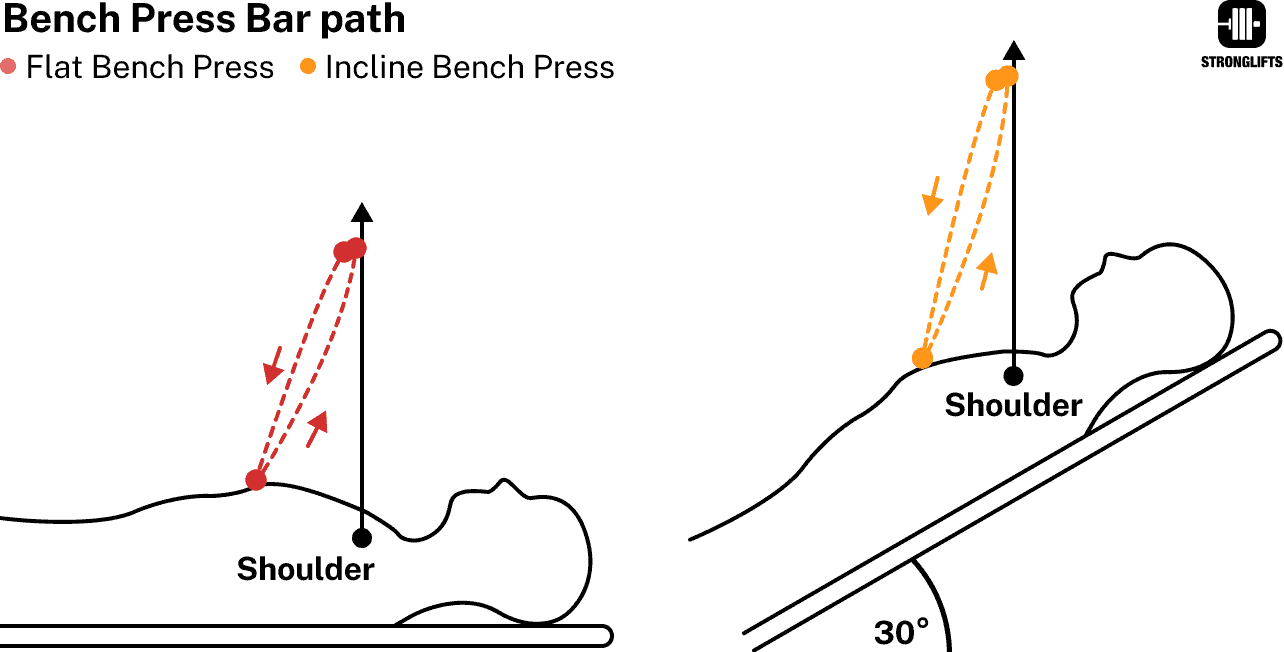
Keep the bench angle under 30 degrees. Steeper angles make the Incline Bench Press too different from the flat bench and may not increase it as much. Angles over 30 degrees also work your chest less (10).
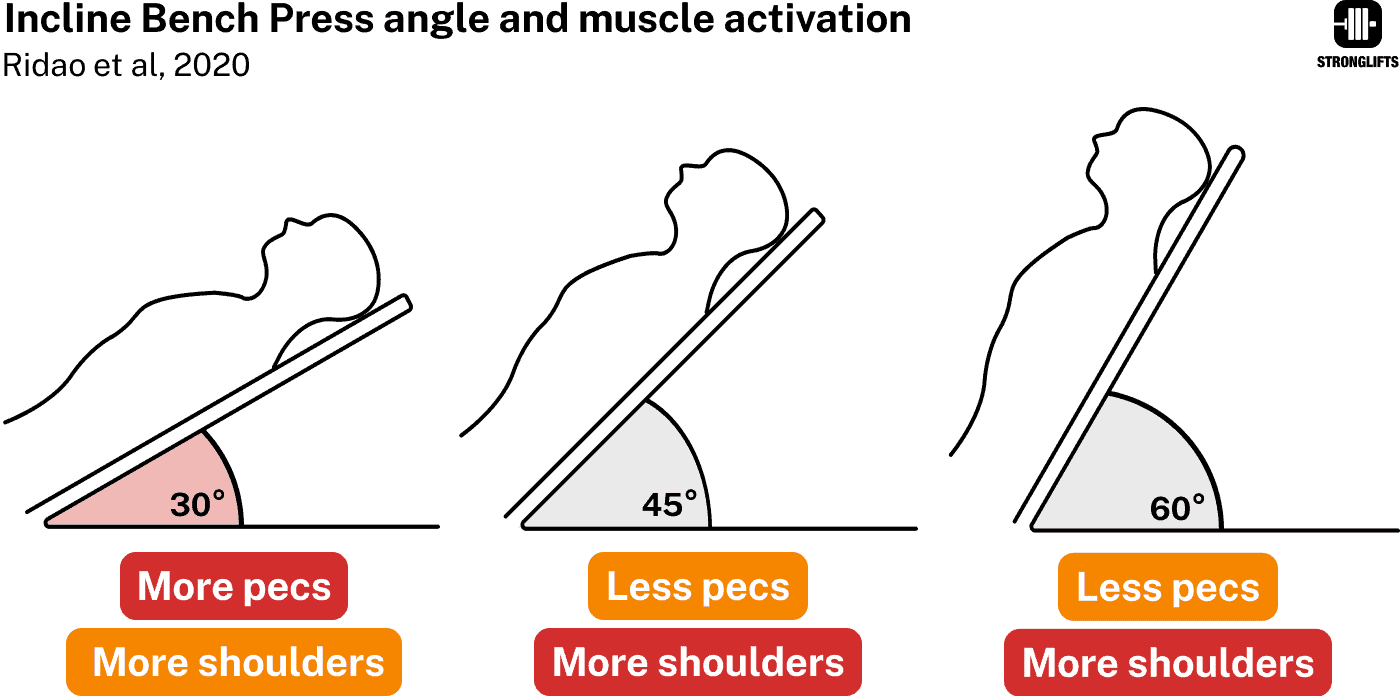
A study by Ridao et al showed that a 45-60 degree Incline Bench Press works your shoulders a little more but your chest far less (10). It turns the exercise more into an Overhead Press. Many lifters make the mistake of using steep bench angles thinking that it works the upper-chest more. But a 30-degree Incline Bench Press actually works your upper-chest more.
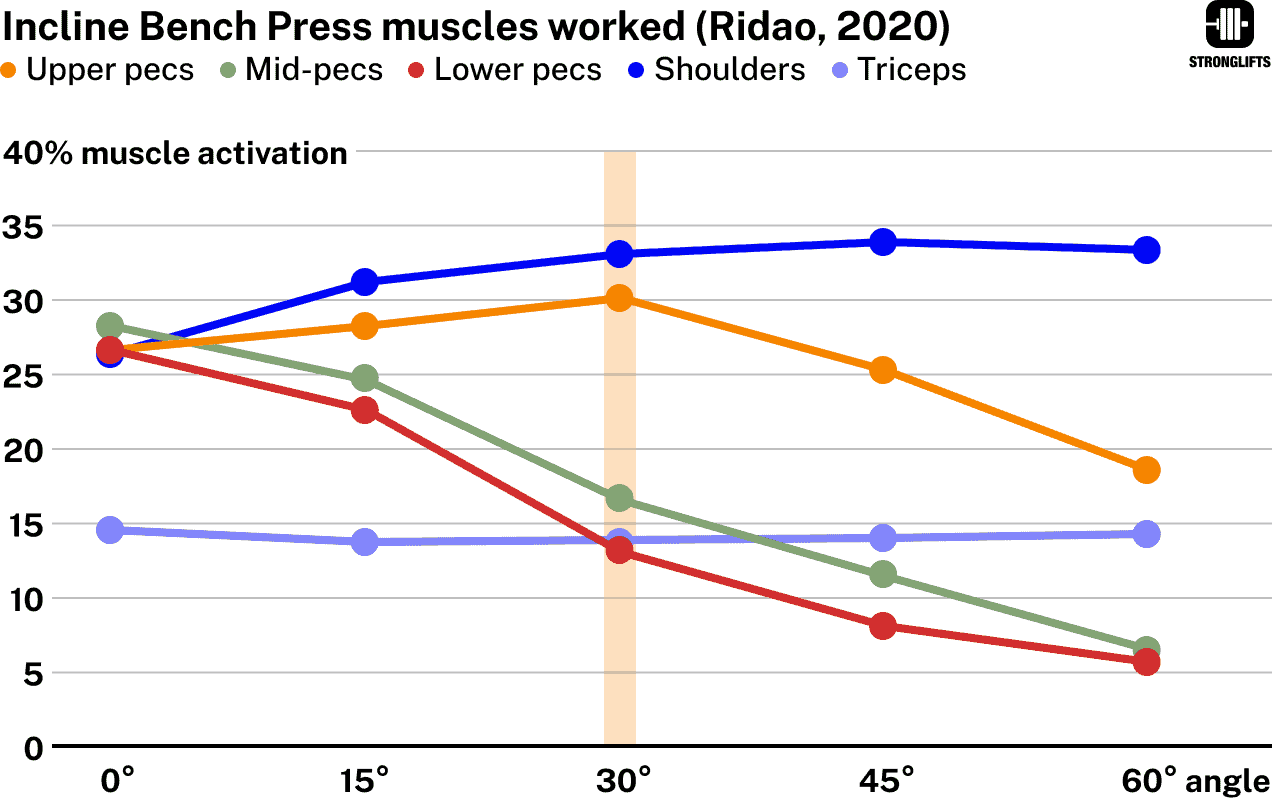
The 30-degree Incline Bench Press encourages a diagonal bar path. This is more effective and helps you increase your Bench Press. The extra upper-chest work is the cherry on the cake. Another study even showed that the Incline Bench Press works your biceps a little more (11).
Bench Feet up
The Bench Press Feet up is a bench done without the support of your feet on the ground. You can keep your feet in the air with your hips bent. Or you can keep your feet in front of you with your legs straight (“Larsen press“).
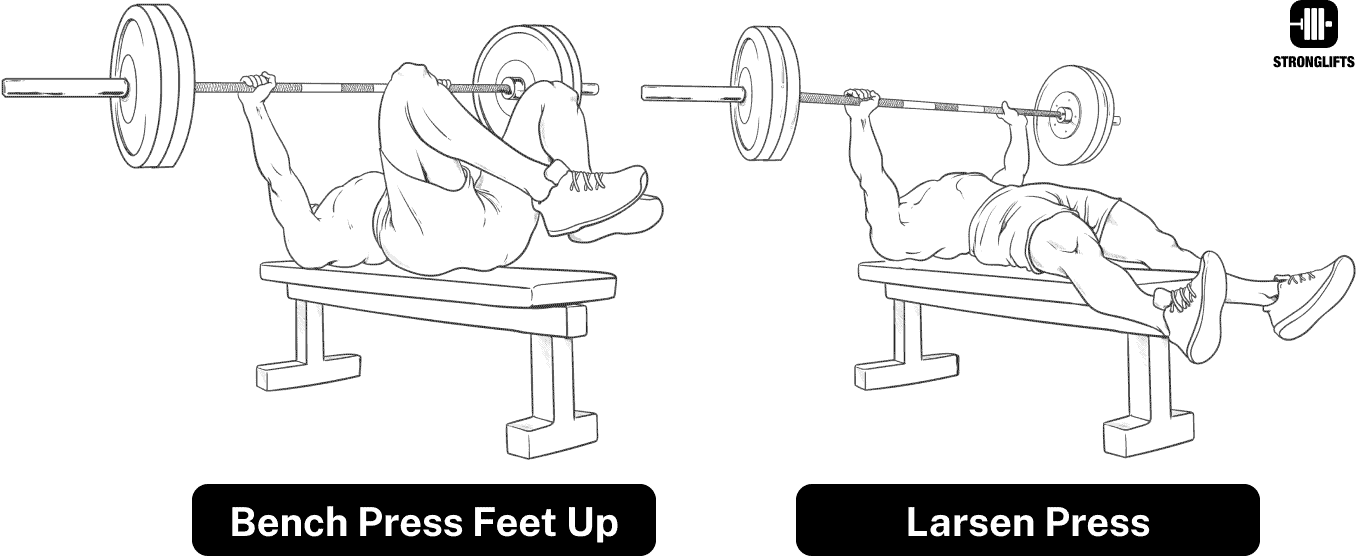
Benching with your feet off the floor is less stable. Your legs can’t help to balance yourself on the bench. This forces your upper-body muscles to work harder to stabilize your body and balance the weight.
A study by Muyor et al found that your chest, shoulders and triceps all work harder when you Bench Press with your feet up (12).
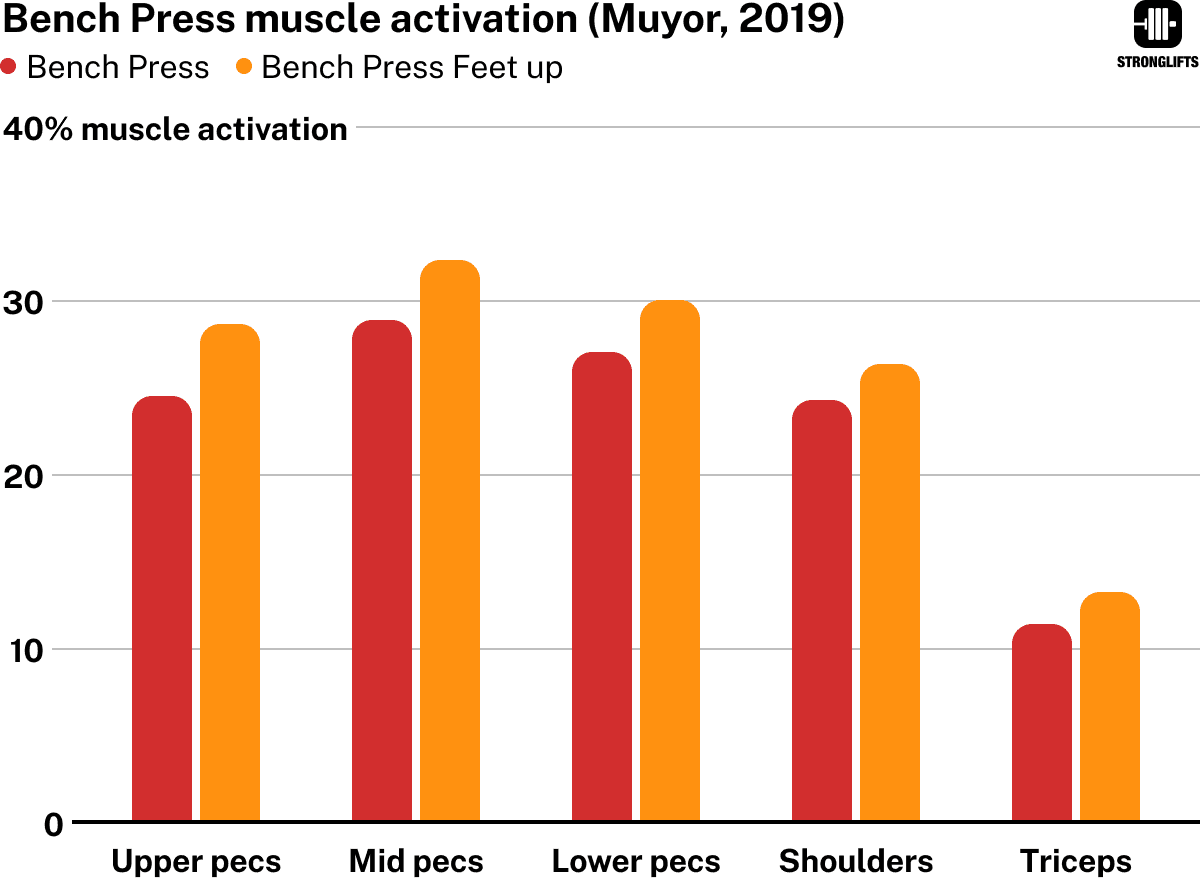
The same study also found that your forearms, abs, obliques and quads contract harder when you Bench Press with your feet up (12). These muscles have to work harder to stabilize your body and balance the weight when you don’t have the support of your feet on the ground.
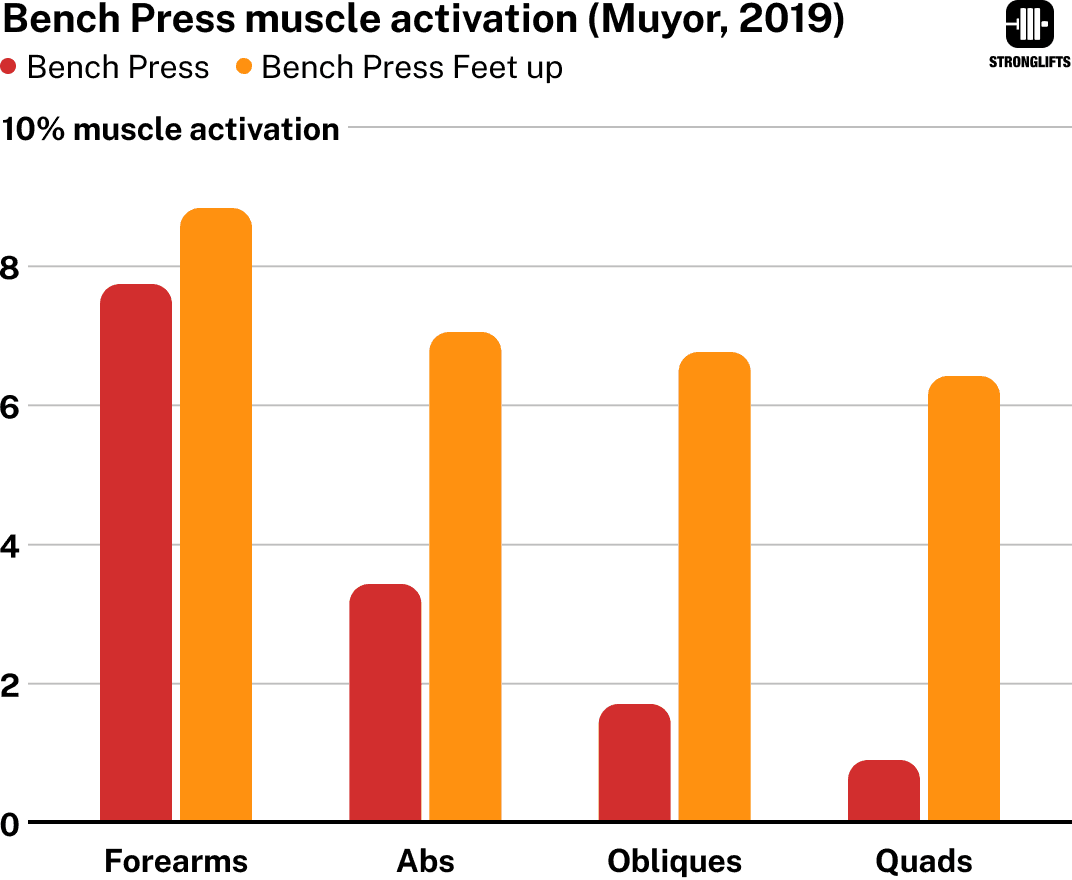
Expect to lift about 20% less weight on the Bench Press Feet up. Improving your ability to balance your body and the weight will result in a more stable position when you Bench Press with your feet on the floor. It also shows you the importance of using your legs on the Bench Press.
In workout B you do Bench Press Feet up right after the Incline Bench Press. Your chest, shoulders and triceps will be tired from doing the Incline Bench first. This is normal, and it will increase the muscular endurance of your upper body muscles. Just do your best and enjoy the pump.
Workout C
The workout C of Stronglifts 5×5 Intermediate is an SBD day. You do the Squat, Bench Press and Deadlift on the same day like powerlifters do in competition. But instead of doing the main lifts you do variations.
There are several variations of workout C as I’ll show you below. With the pause lifts version of Stronglifts 5×5 Intermediate program, you do the Pause Squat, Pause Bench Press and Pause Deadlift in workout C.
| Stronglifts 5×5 Intermediate | ||
|---|---|---|
| Workout A | Workout B | Workout C |
| Squat 5×5 | Deadlift 5×5 | Pause Squat 5×3 |
| Bench Press 5×5 | Incline Bench Press 5×8 | Pause Bench 5×3 |
| Barbell Rows 5×8 | Bench Press Feet up 5×8 | Pause Deadlift 2×3 |
| Assistance work | Assistance work | Assistance work |
A superficial view of workout C is that it’s another full body workout because you train your upper and lower body on the same day. Or that it’s a push, pull, leg day because you Squat (legs), Bench Press (push) and Deadlift (pull). While that’s true, there’s a lot more going on here.
Workout C is a skill day. You do exercises that help you become more technically proficient at the main lifts. This is important because strength = skills × muscle (13, 14). Better technique helps you do more reps and lift heavier weights. Workout C helps you develop your skills like this…
- Although you only Squat, Bench and Deadlift once a week (in A/B) you do variations in workout C. So you’re actually doing Squats 2x/week, Bench 3x/week and Deadlift 2x/week like powerlifters do (6). This gives you more practice to improve your technique.
- Exercise variations can help you target weak areas and focus harder on parts of your form. Changing exercises is also more effective than changing reps for breaking through plateaus (2).
However, although you Squat 2x/week, Bench 3x/week and Deadlift 2x/week, you only do the main lifts once a week. The rest of the week you do variations. The result is that you do nine different exercises per week (including Barbell Rows). Here’s how that helps you to progress…
- You’re only adding weight once a week on each exercise. This slower progression is more sustainable past the easy beginner gains where adding weight on the same Squat 3x/week is no longer realistic.
- You get nine chances to break personal records each week. Maybe you can’t add weight on Squats this week but you can on Pause Squats. This helps you feel like you’re making progress even if not on every exercise. Your training is more motivating.
- Some people get bored faster when they do the same five exercises over and over again. On Stronglifts 5×5 Intermediate you do almost two times more exercises than on Stronglifts 5×5 (9 vs 5). You do different exercises each workout. This can be more fun.
In workout C you do sets of three reps. Five sets on the Squat and Bench but two on Deadlifts. I’ll explain why in the sets & reps section below.
Program variations
Stronglifts 5×5 Intermediate comes with several variations of workouts C. There are three reasons for this…
- Deciding how you’ll do the program can improve your motivation and results (15). If you know what’s holding your back, then making your own choices can help you pick what you need to progress better.
- You see examples of how you can change Stronglifts 5×5 Intermediate without breaking its effectiveness. If you understand the program’s logic then you can make informed decisions if you decide to customize the program for your preferences or needs.
- No program will work forever. Your body adapts to everything. Variety is a fundamental principle of progression (1, 16). Program variations give you something to switch to when you get stuck or need a change.
Every Stronglifts 5×5 Intermediate variation has the same workouts A and B but different workouts C. Let me show you the differences.
Pause lifts
This is the main variation of Stronglifts 5×5 Intermediate that I recommend most people do right after Stronglifts 5×5.
| Stronglifts 5×5 Intermediate | ||
|---|---|---|
| Workout A | Workout B | Workout C |
| Squat 5×5 | Deadlift 5×5 | Pause Squat 5×3 |
| Bench Press 5×5 | Incline Bench Press 5×8 | Pause Bench 5×3 |
| Barbell Rows 5×8 | Bench Press Feet up 5×8 | Pause Deadlift 2×3 |
| Assistance work | Assistance work | Assistance work |
In this variation you do the Pause Squat, Pause Bench Press and Pause Deadlift in workout C.
- The Pause Squat is a regular Squat where you pause for two seconds at the bottom before you come back up.
- The Pause Bench Press is a regular Bench where you pause for two seconds when the bar touches your chest before pressing it up.
- The Pause Deadlift is a Deadlift where you pause for two seconds during the movement. You can either pause when the bar is right below your knees. Or you can pause right after the bar leaves the floor. After the pause pull the weight all the way up to the top.
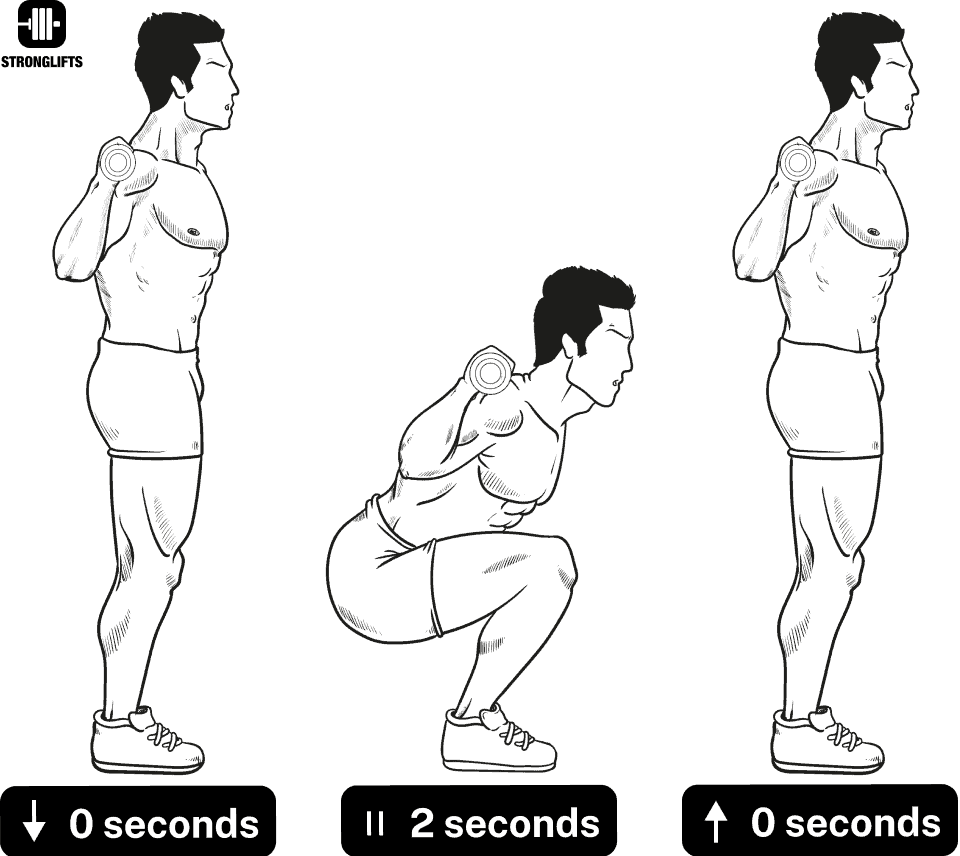
The bottom of the Squat and Bench are the hardest parts of the lifts (17, 18, 19). Your body is in a mechanically weak position that makes it hard for your muscles to apply force. As you bounce out of the bottom of the Squat, the bar speed increases before it drops as you reach the “sticking point” (18).
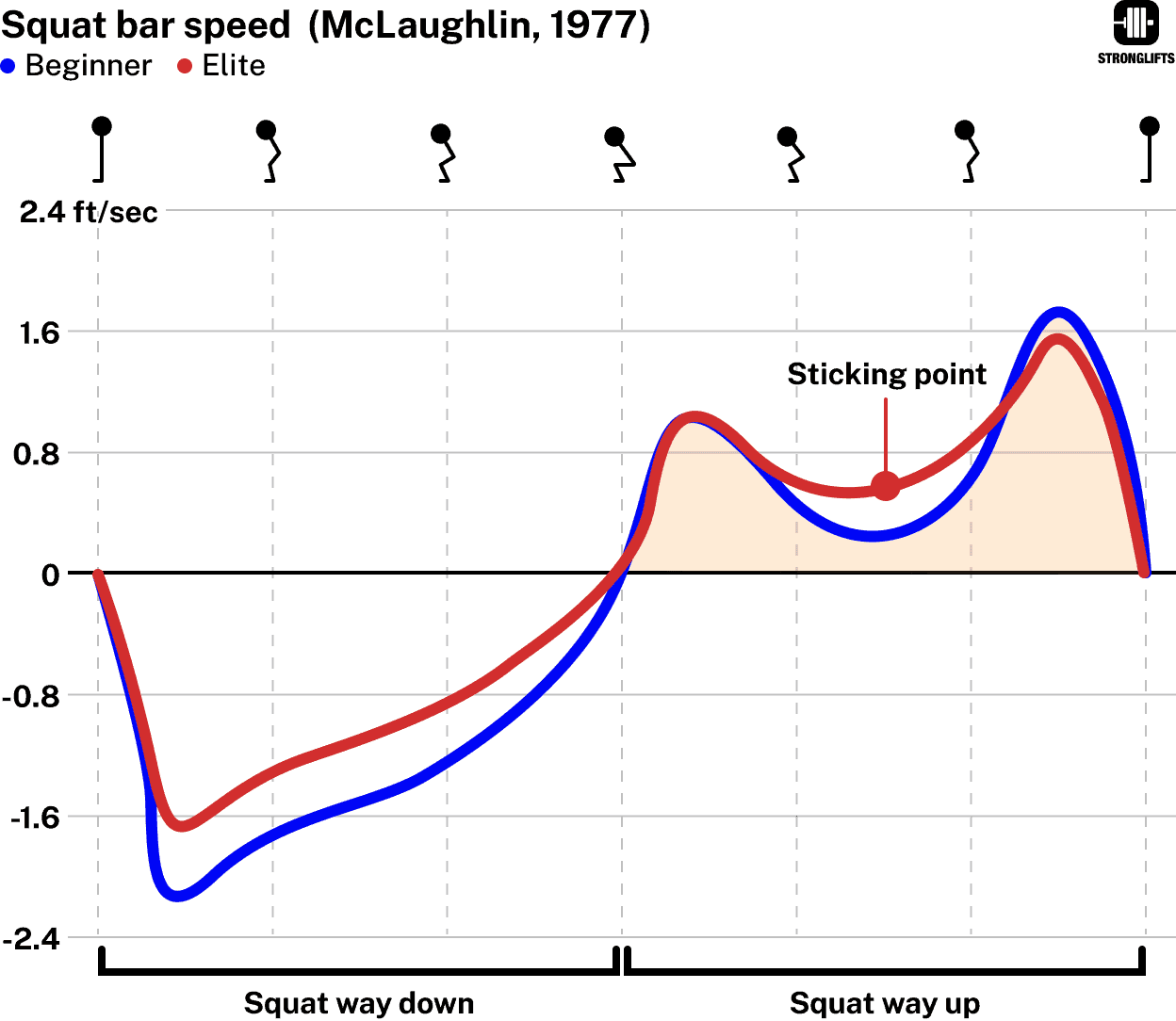
The bar speed of less skilled Squatters drops more after they bounce out of the bottom. A study by Miletello et al found that elite powerlifters accelerated faster out of the bottom of the Squat than beginners (20).
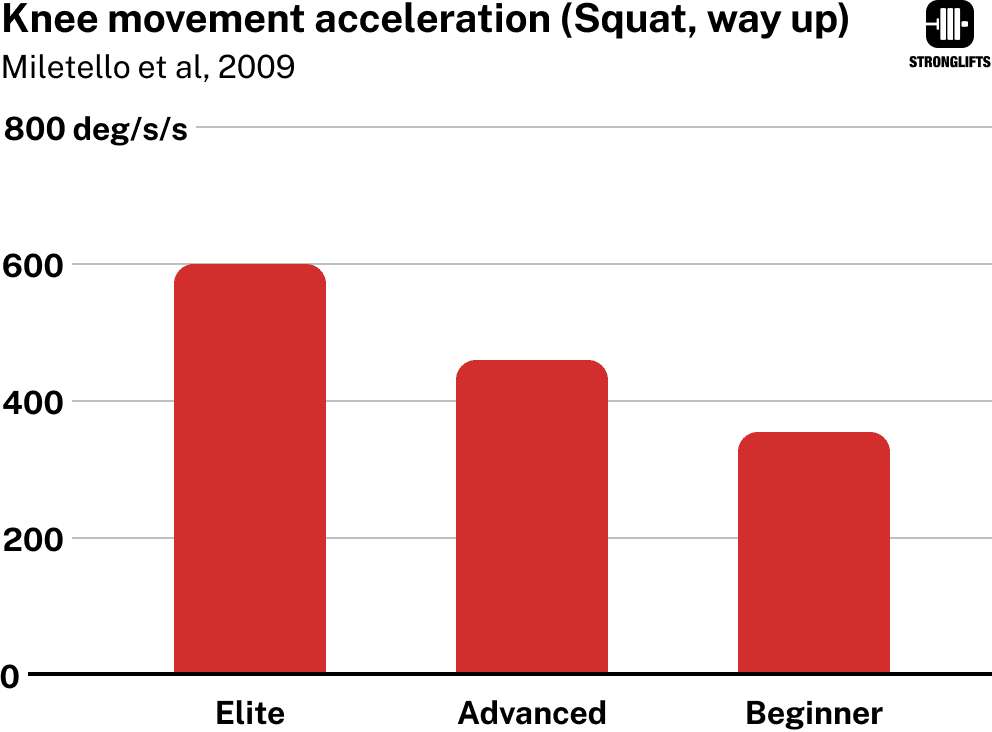
Increasing your ability to accelerate out of the bottom of the Squat and Bench Press helps you lift more weight. You will be able to push harder through the most difficult parts of the movements.
The Pause Squat and Pause Bench Press strengthen the bottom part of the movement. The pause kills the stretch reflex – it eliminates the bounce you normally get at the bottom. This forces your muscles to generate force from a dead stop. Expect to lift 10-20% less weight than on your regular Squat and Bench. However those lifts will become easier as a result.
The Pause Deadlift also makes your muscles generate power in the hardest past of the exercise. The pause breaks your momentum during the lift. The Deadlift is a segmented movement (17). It consists of three phases.
- First you lift the bar off the floor by straightening your knees.
- Then you pull the bar past your knees by straightening your hips.
- Finally you complete the lift by locking your hips and knees.
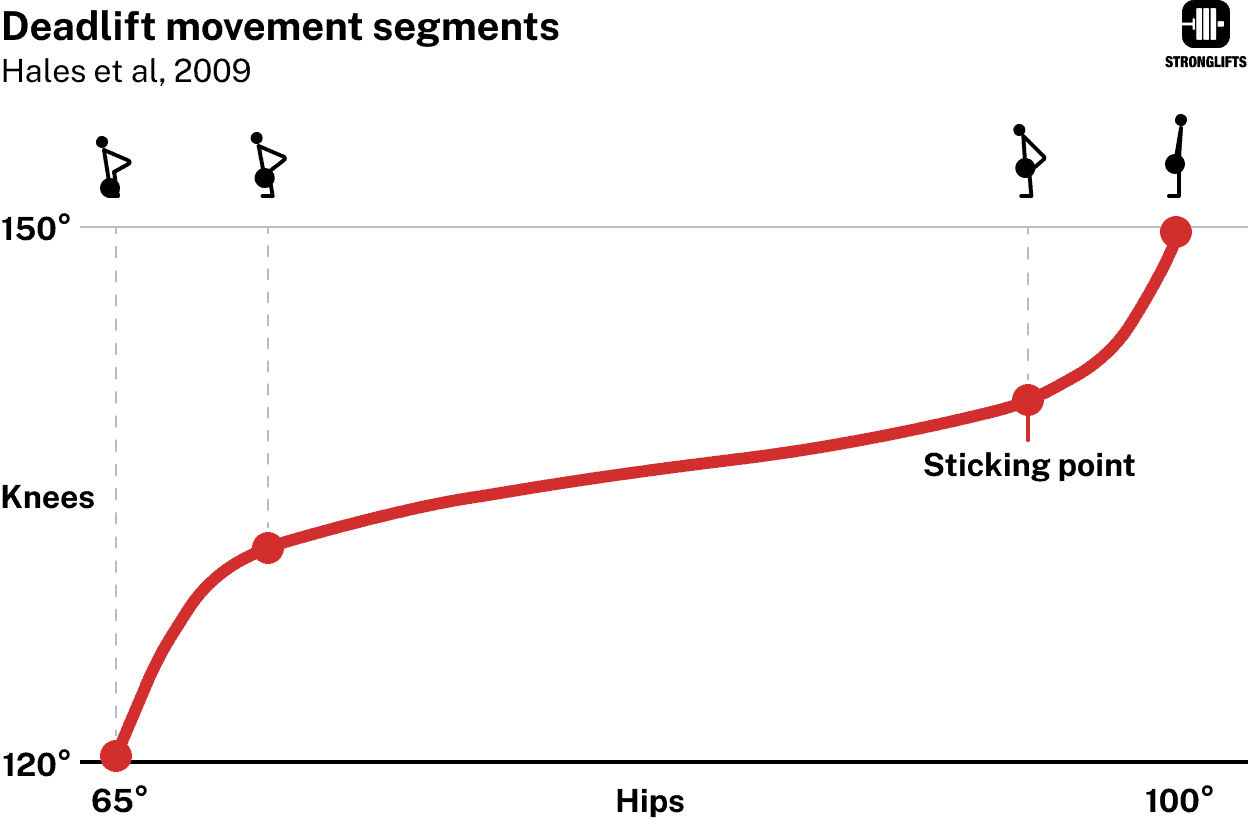
There are two ways to Pause Deadlift, The first one is to pause right after the bar leaves the floor. The second one is to pause when the bar is right below your knees. In both cases you hold the barbell for two seconds in the air, against your legs, before pulling the weight all the way to the top.
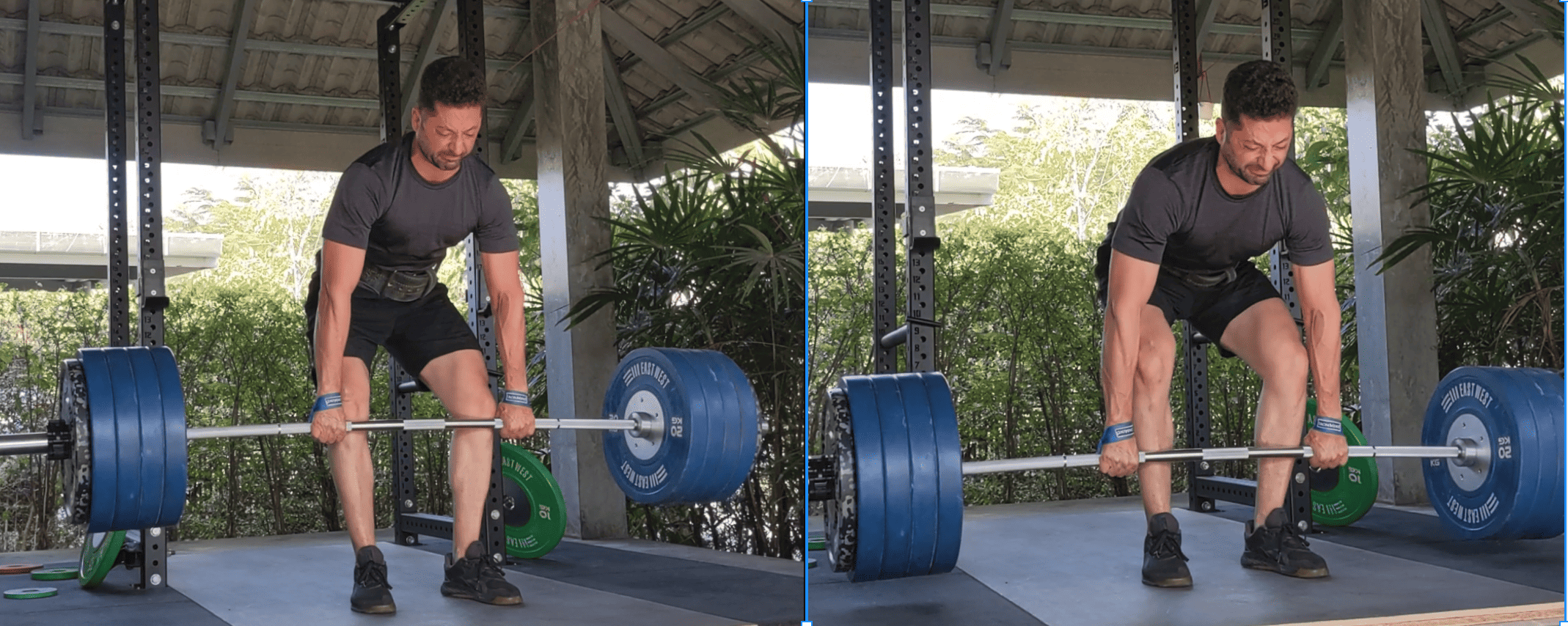
The best position to pause depends on your weakness on the Deadlift. For example, my heavy Deadlifts usually leave the floor quickly but I struggle once the bar passes my knees (example). If you do too, then pause when the bar is right below your knees. On the other hand, if you usually struggle to initiate the lift off the floor, then pause right after the bar leaves the ground.
The Pause lifts will also improve your technique for the main lifts.
- Beginners often relax at the bottom of the Squat and Bench. This results in inconsistent technique and power loss. The pause teaches you to keep your body tight in the bottom position. This increases stability and efficiency, which helps you lift more weight.
- Pause Squats can fix depth issues. Pausing at the bottom gives you more time to focus on the position. It helps you become comfortable. Pausing with a heavy weight on your back also acts as a stretch for your hips and ankles. It improves your flexibility.
- Pause Deadlifts teach you to keep the bar in contact with your legs on the way up. This makes the weight easier to lift and is less stressful on your lower back (21). The Pause Deadlift can also fix issues like raising your hips too fast or not keeping the bar balanced over your midfoot.
The pause version of Stronglifts 5×5 Intermediate is recommended if you struggle with these technical mistakes…
- You can’t hit the proper depth on the Squat
- You tend to relax at the bottom of your Squat and Bench
- You don’t keep the bar in contact with your legs on Deadlifts
For most people who just did Stronglits 5×5, I recommend starting with the pause version of Stronglifts 5×5 Intermediate. You already know how to Squat, Bench Press and Deadlift. You simply add a two second pause during the movement. This makes the transition simple and easy.
The Stronglifts app has the Pause lifts variation. Download the app, then go to program – select Stronglifts 5×5 Intermediate – select Pause Lifts. Everything will be setup for you.
Tempo Lifts
The tempo variation of Stronglifts 5×5 Intermediate consists of doing the main lifts with a slower tempo in workout C.
| Stronglifts 5×5 Intermediate | ||
|---|---|---|
| Workout A | Workout B | Workout C |
| Squat 5×5 | Deadlift 5×5 | Tempo Squat 600 5×3 |
| Bench Press 5×5 | Incline Bench Press 5×8 | Tempo Bench 600 5×3 |
| Barbell Rows 5×8 | Bench Press Feet up 5×8 | Tempo Deadlift 600 2×3 |
| Assistance work | Assistance work | Assistance work |
600 stands for the tempo you use when performing the exercises in workout C. Here’s how to do 600 tempo on the Squat, Bench and Deadlift…
- Tempo Squat 600 means you take six seconds to lower the weight, then quickly lift it back up.
- Tempo Bench 600 means you take six seconds to lower the weight, then quickly press it back up.
- Tempo Deadlift 600 means you pull the weight all the weight up. You then take six seconds to lower the weight to the floor.
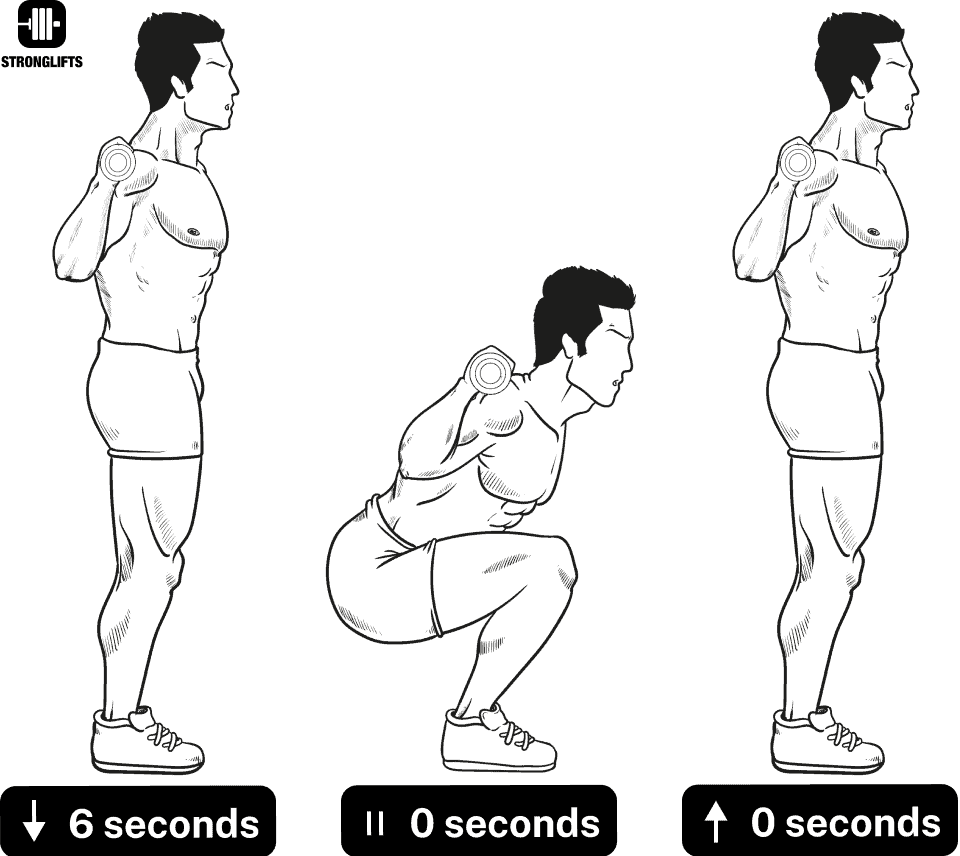
Slower tempo work reinforces proper technique by making you control the weight more. It helps you practice proper depth on the Squat, keep your chest up on the Bench Press, and hold the bar close on the Deadlift.
Studies by McLaughlin and Miletello found that less skilled lifters lower the weight faster when they Squat down (18, 20). Elite powerlifters move the weight more slowly on the way down (but faster on the way up).
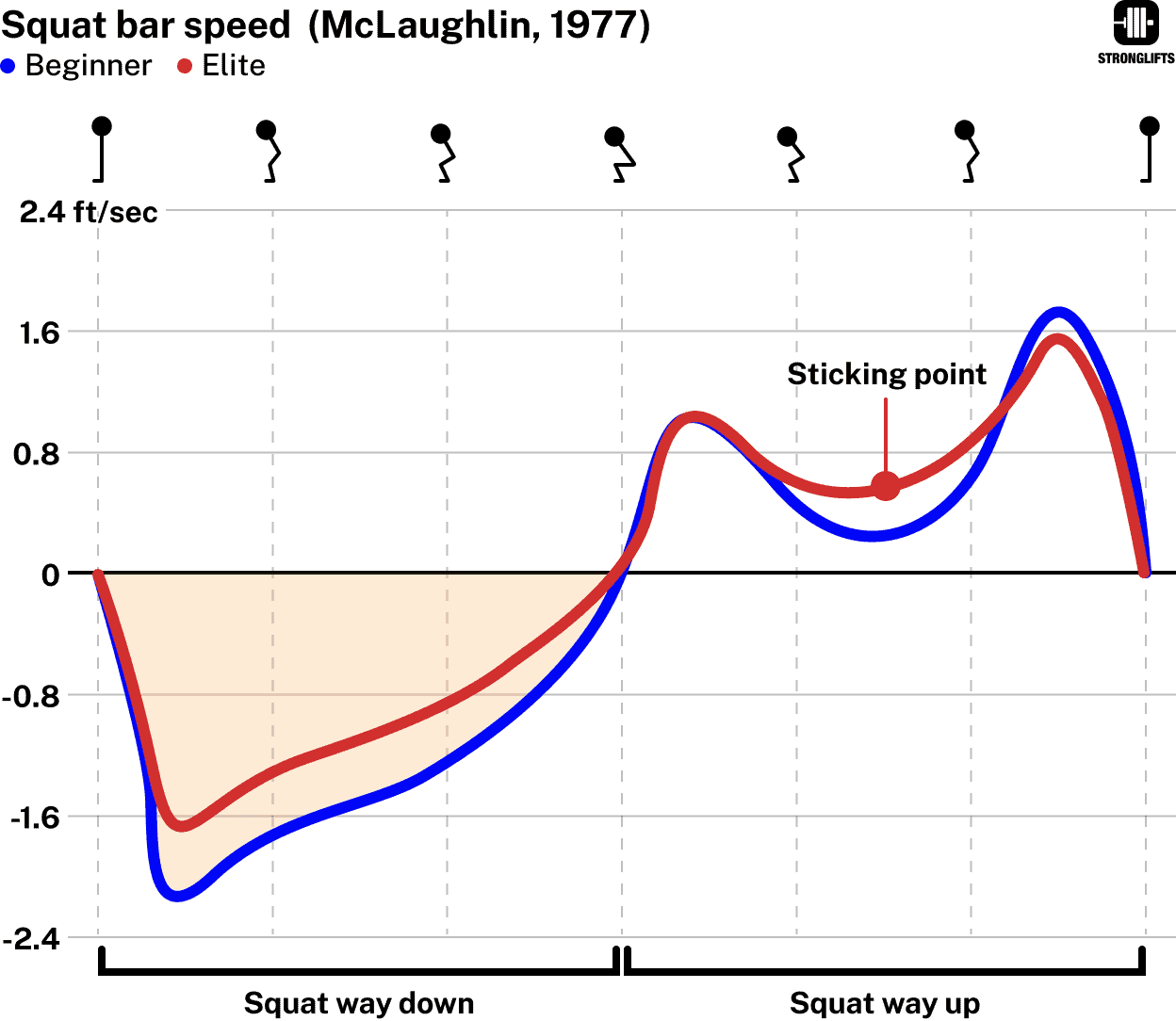
The same thing happens on the Bench Press. Studies by McLaughlin et al found that less skilled lifters lower the weight faster to their chest (7, 22). Elite lifters control the bar better on the way down and move it more slowly.
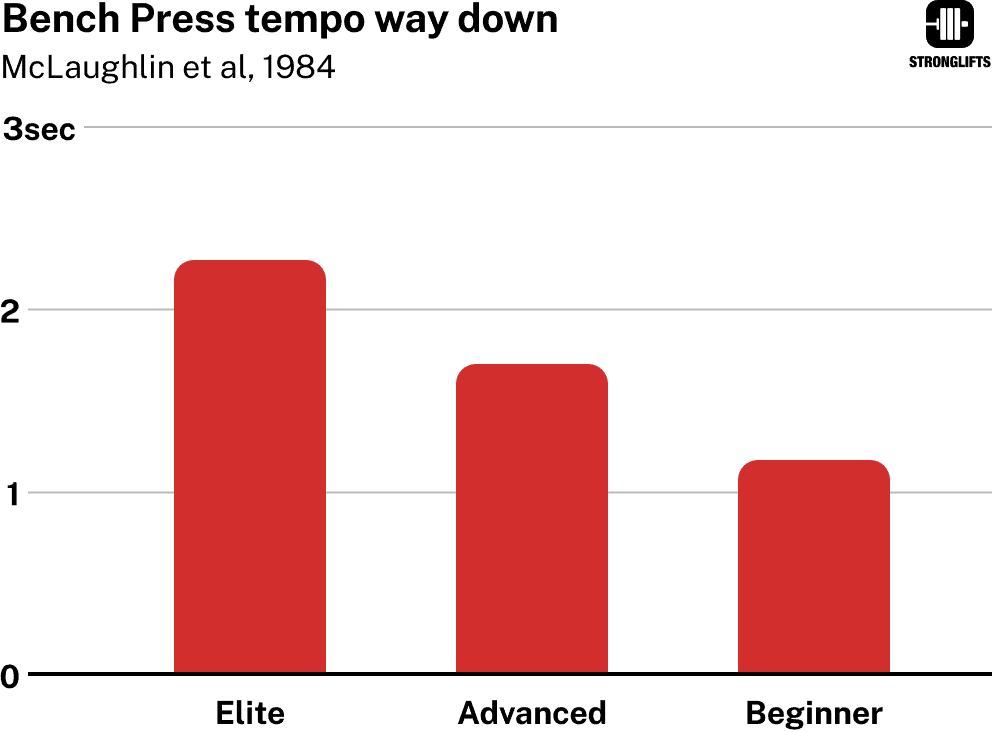
Moving the weight too fast on the way down can result in inconsistent form on the way up. Dropping the weight quickly on the Squat and Bench Press can cause knee, hip or shoulder pain. Tempo lifts force you to lower the weight slowly and under control. This can help you perform the main Squat and Bench with better form on the way down.
The tempo lifts version of Stronglifts 5×5 Intermediate is recommended if you struggle with these technical mistakes:
- You tend to drop the weight too fast on the Squat and Bench
- You struggle with proper balance on the Squat and Bench
- Your tend to relax at the bottom of your Squat and Bench
- You don’t keep the bar in contact with your legs on Deadlifts
Lowering the bar slowly makes the same weight a lot harder. Expect to lift 10-20% less on the tempo exercises than the main ones.
The Stronglifts app has the Tempo lifts variation. Download the app, then go to program – select Stronglifts 5×5 Intermediate – select Tempo Lifts. Everything will be setup for you.
Rack lifts
The rack variation of Stronglifts 5×5 Intermediate involves doing pin work and partials in workout C. You need a Power Rack for this.
| Stronglifts 5×5 Intermediate | ||
|---|---|---|
| Workout A | Workout B | Workout C |
| Squat 5×5 | Deadlift 5×5 | Pin Squat 5×3 |
| Bench Press 5×5 | Incline Bench Press 5×8 | Pin Press 5×3 |
| Barbell Rows 5×8 | Bench Press Feet up 5×8 | Rack Pull 2×3 |
| Assistance work | Assistance work | Assistance work |
In this variation you do the Pin Squat, Pin Press and Rack Pulls in workout C.
- The Pin Squat is a Squat where you lower the bar until it rests on the pins of the Power Rack and then lift it back up. Your hips should be right below the top of your knees when the bar rests on the pins.
- The Pin Press is a Bench where you lower the bar until it rests on the pins of the Power Rack and then lift it back up. The pins should be slightly above your chest level. The bar should be able to rest on the pins without you having to sink your chest.
- The Rack Pull is a Deadlift where the bar starts about 2.5inch / 6cm below your knees (17). You pull the bar off the pins to the top, then lower it back to the pins under control.
The Pin Squat and Pin Press strengthen the bottom and hardest position of the lift. Resting the bar on the pins teaches you to accelerate from a dead stop. This is key for getting stronger (20). Both lifts kill the stretch reflex so expect to lift ~10-20% less weight than on regular Squats and bench.
The Rack pull is an overload movement (23). You’re starting each pull from a higher position than on Deadlifts. The range of motion is shorter which makes it possible to lift 10-20% more. This can help your main Deadlifts feel lighter in your hand as you’ve lifted heavier weights with Rack Pulls.
Pause Squat, Pause Bench, Pin Squat and Pin Press all make you break the movement at the bottom of the lift. They teach you to accelerate from a dead stop. The difference is that your muscles support the weight at the bottom of pause lifts. With rack lifts, the pins support the bar. Keep your muscles tight regardless. Don’t drop the bar on the pins. Lower it under control.
The rack lifts version of Stronglifts 5×5 Intermediate is recommended if…
- You struggle with proper balance on the Squat and Bench
- You’re weaker in the bottom of the Squat and Bench (most people are)
- You liked the pause lifts and want something similar but different
- You think your Deadlift would benefit from heavy Rack Pulls
There are two drawbacks to this variation of Stronglifts 5×5 Intermediate. One, you need a power rack to do these lifts. Two, you’ll use the rack the whole workout. While this saves you time, others can’t use the rack. This can be a problem if your gym only has a few racks or if you train at busy times.
The Stronglifts app has the Rack lifts variation. Download the app, then go to program – select Stronglifts 5×5 Intermediate – select Rack Lifts. Everything will be setup for you.
Alternate lifts
The alternate lifts variation of Stronglifts 5×5 Intermediate puts less specific variations of the main lifts in workout C.
| Stronglifts 5×5 Intermediate | ||
|---|---|---|
| Workout A | Workout B | Workout C |
| Squat 5×5 | Deadlift 5×5 | Front Squat 5×3 |
| Bench Press 5×5 | Incline Bench Press 5×8 | Overhead press 5×3 |
| Barbell Rows 5×8 | Bench Press Feet up 5×8 | Sumo Deadlift 2×3 |
| Assistance work | Assistance work | Assistance work |
The Front Squat puts the barbell on your front shoulders instead of your back like Squats do. The Overhead Press involves pressing the weight vertically instead of horizontally like on the Bench Press. The Sumo Deadlift puts your arms inside your legs unlike the conventional Deadlift.
The exercises in workout C are therefore very different from the ones in workouts A and B. If you want more exercise variety, you want to keep the Overhead press in your program, or you want to try Front Squats and Sumo Deadlifts, then you’ll like this version of Stronglifts 5×5 Intermediate.
There are two drawbacks to this variation:
- The learning curve is steeper. Technique on Front Squats and Sumo Deadlifts is quite different from regular Squats and Deadlifts. Front Squats require more wrist flexibility. You’ll need a period of adjustment where you’ll lift lighter than you can to learn the form.
- The Bench Press frequency is lower – you’re benching 2x/week instead of 3x. This can affect your progress on the Bench Press.
If you want to do less back squats, bench press and conventional deadlifts for a few weeks, then try this variation of Stronglifts 5×5 Intermediate.
The Stronglifts app has the Alternate lifts variation. Download the app, then go to program – select Stronglifts 5×5 Intermediate – select Alternate Lifts. Everything will be setup for you.
Dumbbell Lifts
The dumbbell lifts variation of Stronglifts 5×5 Intermediate puts dumbbell exercises in workout C.
| Stronglifts 5×5 Intermediate | ||
|---|---|---|
| Workout A | Workout B | Workout C |
| Squat 5×5 | Deadlift 5×5 | Dumbbell Lunges 5×8 |
| Bench Press 5×5 | Incline Bench Press 5×8 | Dumbbell Bench Press 5×8 |
| Barbell Rows 5×8 | Bench Press Feet up 5×8 | Dumbbell Romanian Deadlift 2×8 |
| Assistance work | Assistance work | Assistance work |
There are two benefits to this variation:
- Dumbbell exercises work both sides of your arms and legs separately. This can help if you have major left/right strength imbalances due to past injuries that made you favor one side more.
- Dumbbell exercises limit how heavy you can go. You’re working one side at a time, and the weight is harder to stabilize. This turns workout C into a much lighter, easier and shorter workout than A and B.
The drawback is that the exercises in workout C are less specific. You’ll get less strength gains on the Squat, Bench Press and Deadlift compared to the program variations that include the Pause, Tempo or Rack lifts.

This isn’t always a bad thing. Maybe you hurt something and want to take it easy for a few weeks. Or maybe you’re going through a busier period and want a shorter and easier workout at the end of the week. This variation can work fine in this case until your situation improves.
The Stronglifts app has the Dumbbell lifts variation. Download the app, then go to program – select Stronglifts 5×5 Intermediate – select Dumbbell Lifts. Everything will be setup for you.
Sets & Reps
Stronglifts 5×5 Intermediate uses different sets and reps on different exercises. On the main lifts you do 5×5, on the variations you do 5×3, and on the rest you do 5×8. In this section I’ll explain why.
5×5
5×5 means five sets of five reps. On Stronglifts 5×5 Intermediate you do 5×5 on the Squat, Bench Press and Deadlift.
| Stronglifts 5×5 Intermediate | ||
|---|---|---|
| Workout A | Workout B | Workout C |
| Squat 5×5 | Deadlift 5×5 | Pause Squat 5×3 |
| Bench Press 5×5 | Incline Bench Press 5×8 | Pause Bench 5×3 |
| Barbell Rows 5×8 | Bench Press Feet up 5×8 | Pause Deadlift 2×3 |
| Assistance work | Assistance work | Assistance work |
On Stronglifts 5×5 you were doing Deadlifts for 1×5 – one heavy set of five reps. This is because you were Squatting 3x/week for 5×5. Deadlifting for 5×5 every other workout on top of that would have been 25 weekly sets for legs. That’s very high volume and too much for most people (24, 25).
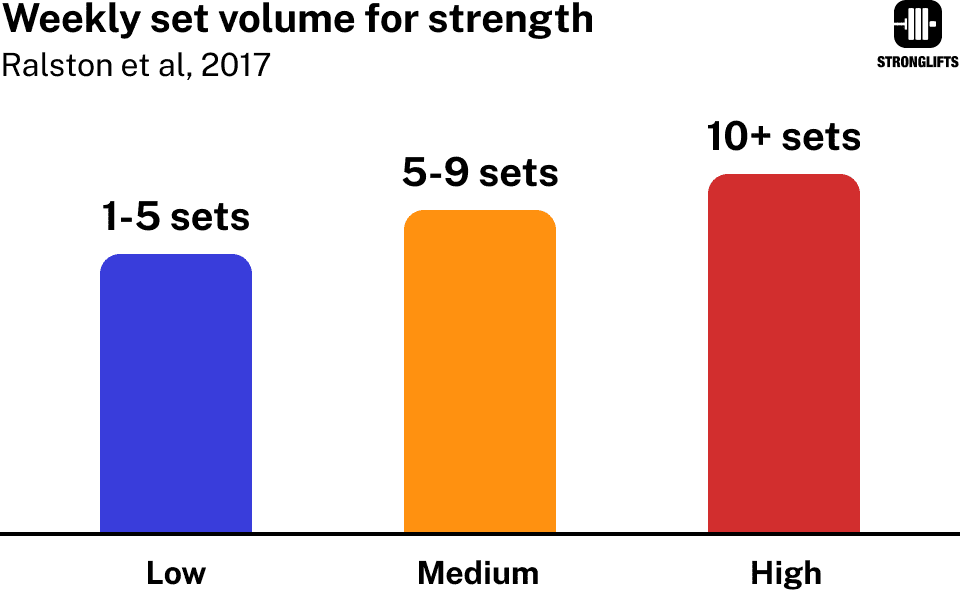
However Squats and Deadlifts work similar muscles. The strength gains carry-over. This was found in a study by Nigro et al which had men Squat 3x/week for six weeks (26). They didn’t Deadlift yet it increased.
| Nigro et al, 2020 | Squat | Deadlift |
|---|---|---|
| Frequency | 3×/week | 0×/week |
| Before | 273lb | 285lb |
| After | 310lb | 304lb |
| Gain | +36lb | +19lb |
On Stronglifts 5×5 Intermediate you’re no longer Squatting 3x/week. There are two reasons for this…
- You know how to Squat now. Each month you did 300 Squat reps on Stronglifts 5×5. You learned how to grip, unrack and balance the bar. You have the basics down. You no longer need so much practice on the Squat. This creates room for more Deadlift practice.
- Your Squat has doubled or even tripled since you started Stronglifts 5×5. This has dramatically increased your volume. Squatting 3x/week with more weight every time is too much at this point.
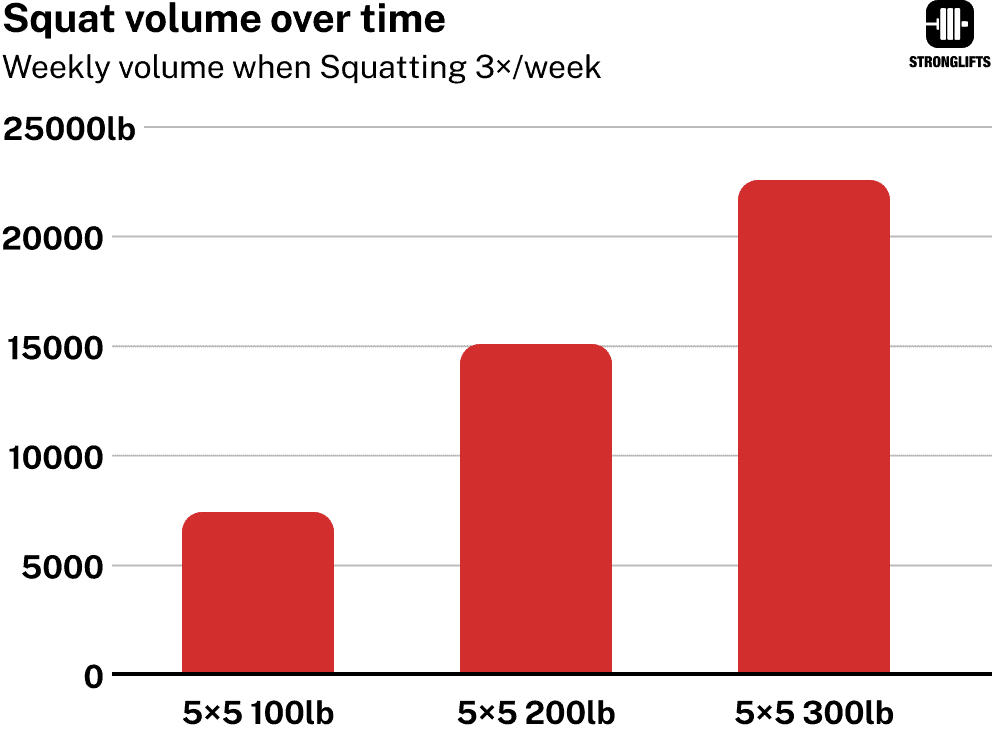
Switching to 2x/week Squats creates a slower, more sustainable progression. Using a variation for your second Squat session slows down the progression further. You’re doing each exercise once a week and so you’re adding weight once a week. This is more realistic past the easy beginner gains where it becomes harder to get stronger due to diminishing returns (3).
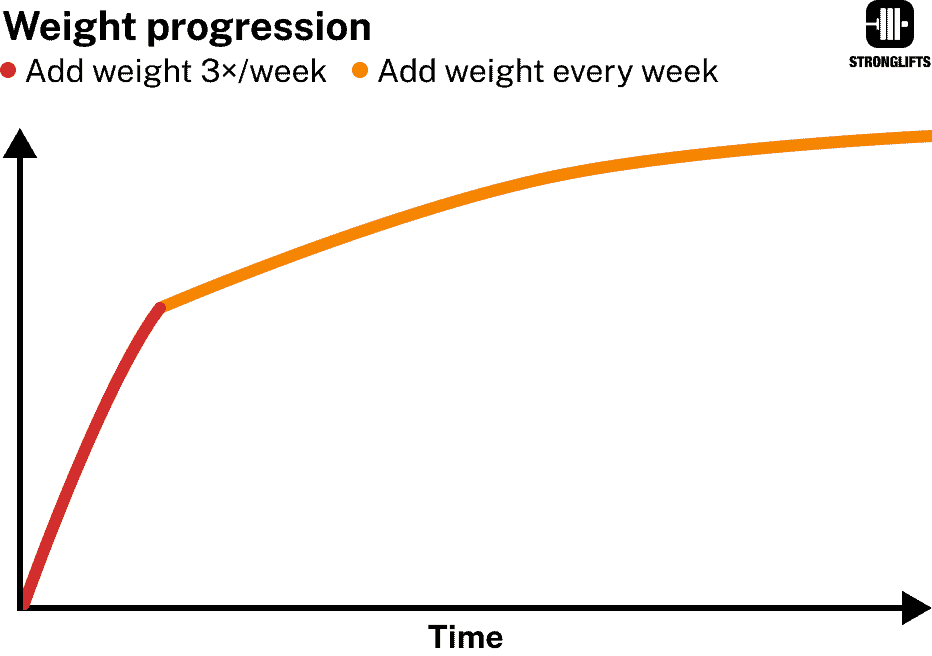
Before you did Deadlift at the end of workout B. This worked because the weights were light. However, once your Squat and Overhead Press became heavier, they created more fatigue. Training the Deadlift hard and heavy after that became difficult. This could hinder your progress.
Now that you only Squat 2x/week, you can start one of the three workouts with Deadlifts – workout B. You Deadlift when you’re fresh and with full focus. This helps you to progress better now that the weights are heavier.
5×5 Deadlifts give you more practice to further improve your technique. This is important because relying on Squats only to increase your Deadlift doesn’t work past the easy beginner gains (17). However, the total weekly set volume for your legs is the same as before on Stronglifts 5×5.
| Volume compared | Stronglifts 5×5 | Stronglifts 5×5 Intermediate |
|---|---|---|
| Squat frequency | 3× | 2× ? |
| Deadlift frequency | 1.5× | 2× ? |
| Squat sets/week | 15 | 10 ? |
| Deadlift sets/week | 1.5 | 7 ? |
| Total leg sets/week | 16.5 | 17 |
5×5 Deadlift isn’t easy. But you do two Bench exercises for high reps next. The Bench works less and smaller muscles. The weight is lighter. Benching for eight reps decreases the weight by ~10% compared to five reps. Benching incline or feet up lowers the weight by another ~20% (10, 11).

While workout B starts hard, the next two lifts are easier. You’re lying on a bench lifting lighter weights. It’s actually a “light” bench day – the weight is lighter than what you Bench Press in workouts A and C.
5×8
5×8 means five sets of eight reps. On Stronglifts 5×5 Intermediate you do 5×8 on the Incline Bench Press, Bench Press Feet up and Barbells Rows. The dumbbell lifts variation also has 5×8 for all exercises in workout C.
| Stronglifts 5×5 Intermediate | ||
|---|---|---|
| Workout A | Workout B | Workout C |
| Squat 5×5 | Deadlift 5×5 | Pause Squat 5×3 |
| Bench Press 5×5 | Incline Bench Press 5×8 | Pause Bench 5×3 |
| Barbell Rows 5×8 | Bench Press Feet up 5×8 | Pause Deadlift 2×3 |
| Assistance work | Assistance work | Assistance work |
Contrary to popular belief, high reps don’t build more muscle. Lower reps build the same amount of muscle given the same volume (27, 28, 29, 30). What’s more important is that you apply progressive overload – you must add weight on the bar over time. This increases the tension on your muscles. Muscular tension is the main driver of muscle growth (31, 32).

For example, a study by Schoenfeld et al compared seven sets of three reps to three sets of ten reps (27). Muscle gains were the same. But the group that did three reps got stronger on the Squat and Bench Press. They lifted heavier weights. If you want to get good at lifting heavy weights, you need to lift heavy weights. This is the fundamental principle of specificity (1, 16). However for building muscle every rep range works. Really.
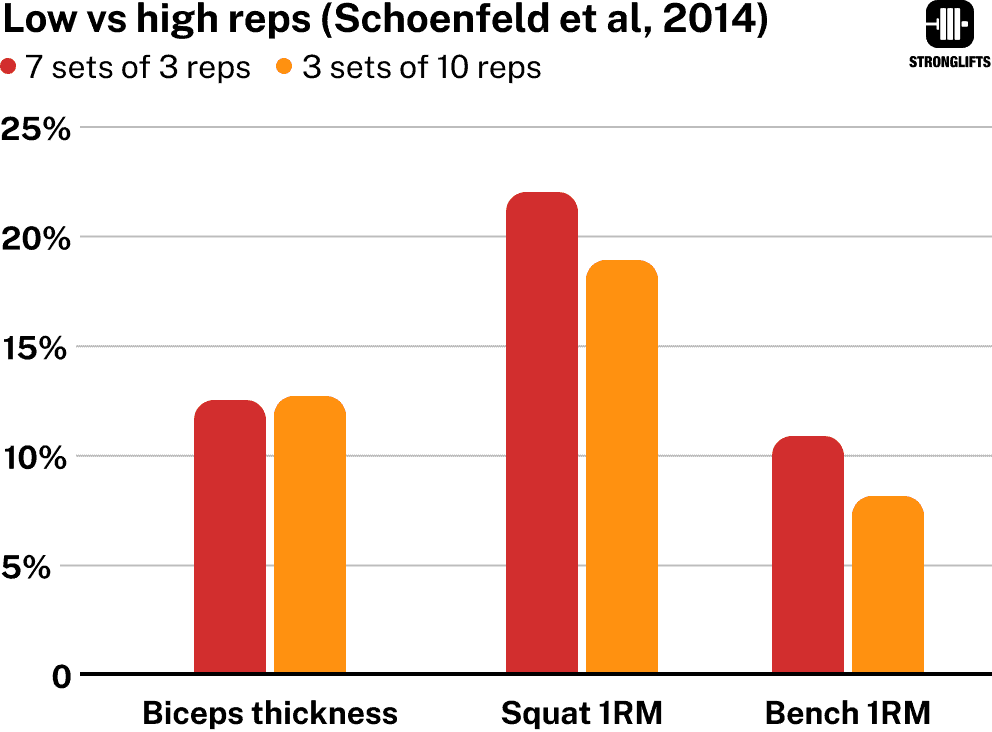
A study by Kubo et al found similar results (29). They compared sets of four, eight and twelve reps. Bodybuilding tells you 8-12 reps builds more muscle. Studies show you every rep range builds the same amount of muscle. But the group that did 12 reps built less strength. They lifted lighter weights.
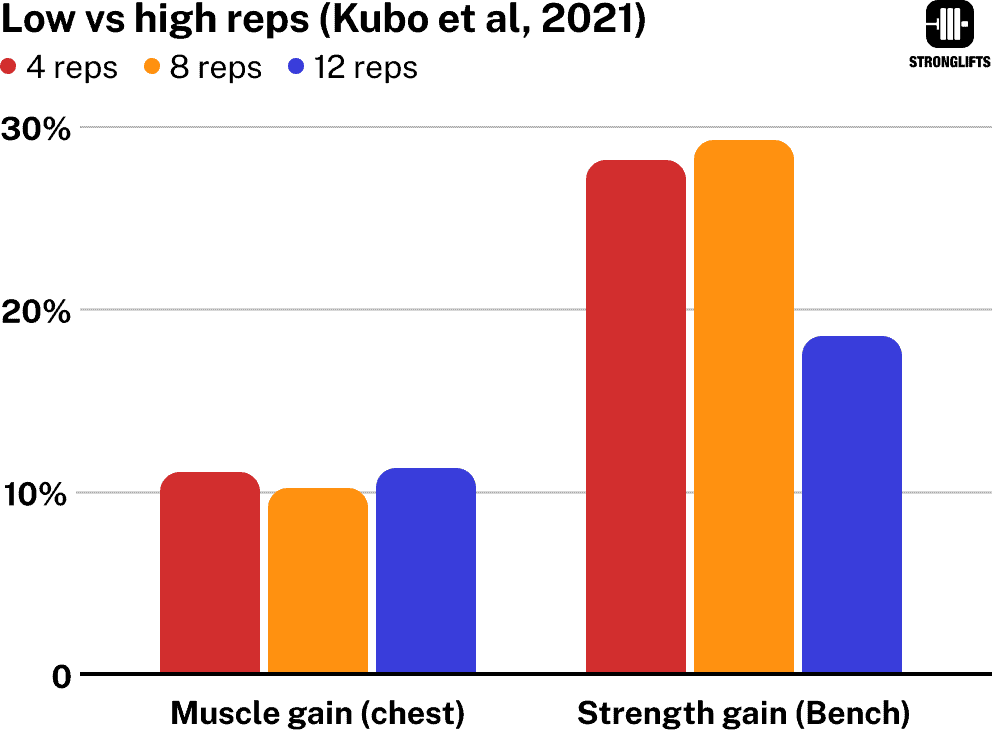
And so it doesn’t matter if you do five, eight or twelve reps when it comes to building muscle. It all works. What matters is that you increase the amount of weight that you lift for your chosen reps. If you double the amount of weight you Row for five reps, then your back and biceps will be bigger than before. Strength is size. The rep range matters more for building strength (33).
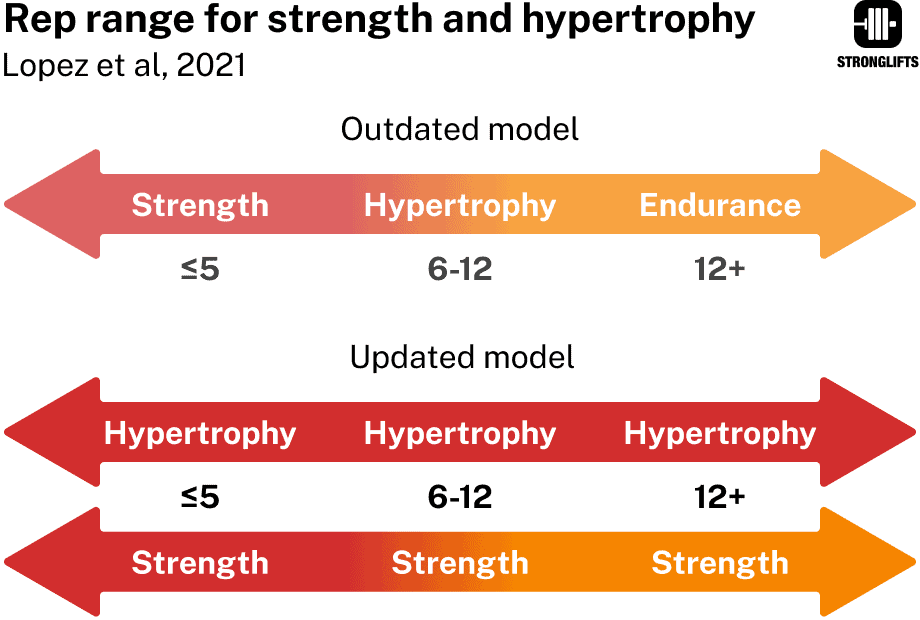
Stronglifts 5×5 had five reps on every lift because you were getting started. The focus was learning form and consistency. Sets of fives are shorter and cause less fatigue. Your form is less likely to break down on technical lifts like the Squat. You get less sore which makes it easier to train the same muscles again. 5×5 is simple and easy to remember as Bill Starr said (34). A simple program design is recommended for new lifters (1). Every rep range builds muscle anyway.
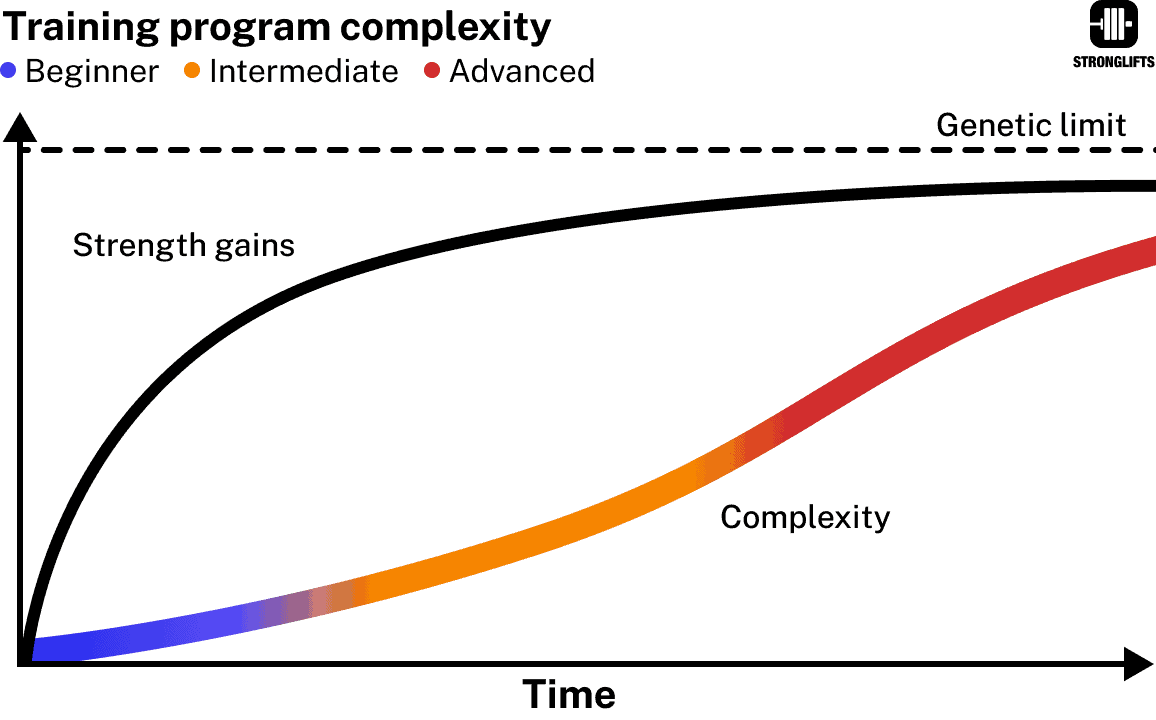
Now if every rep range builds muscle given enough volume, then why not do 5×5 everywhere? Why even bother with 5×8? A few reasons…
- You’re stronger, more muscular and more skilled. You have some of the fundamentals down by this point, including gym consistency. And so the program can be a little more complex than when you started.
- Most people don’t care about how much they lift on exercises like Barbell Rows. Lifters typically don’t ask “how much do you row‘? It’s not a competitive lift. It’s assistance that helps your main lifts. This doesn’t mean we won’t try to row heavier weights – we will. But we’re really doing it to get stronger on the Squat, Bench and Deadlift.
- 5×8 decreases the weight by about 10%. You will be tired after the heavy Squats, Bench and Deadlifts of workouts A and B. The higher reps keep the weight a little lighter after that.
- 5×8 trains your muscles more under fatigue. Your chest, shoulders, back, biceps and triceps will get more pumped. Again, that’s not the main driver of muscle growth – adding weight is. But some people need that pump to feel like they’re working hard and making progress.
Note that the Dumbbell Lifts variation of Stronglifts 5×5 Intermediate also has 5×8 in workout C instead of 5×3.
| Stronglifts 5×5 Intermediate | ||
|---|---|---|
| Workout A | Workout B | Workout C |
| Squat 5×5 | Deadlift 5×5 | Dumbbell Lunges 5×8 |
| Bench Press 5×5 | Incline Bench Press 5×8 | Dumbbell Bench Press 5×8 |
| Barbell Rows 5×8 | Bench Press Feet up 5×8 | Dumbbell Romanian Deadlift 2×8 |
| Assistance work | Assistance work | Assistance work |
Unlike the Pause, Tempo, Rack and Alternate lifts the Dumbbell Lifts aren’t aimed at improving your skills for the main lifts. They’re more assistance exercises to work the muscles that you use on the main lifts. Doing 5×8 therefore makes more sense than 5×3.
5×3
5×3 means five sets of three reps. On Stronglifts 5×5 Intermediate you do 5×3 on the first two exercises of workout C (except in the Dumbbell lifts variation).
| Stronglifts 5×5 Intermediate | ||
|---|---|---|
| Workout A | Workout B | Workout C |
| Squat 5×5 | Deadlift 5×5 | Pause Squat 5×3 |
| Bench Press 5×5 | Incline Bench Press 5×8 | Pause Bench 5×3 |
| Barbell Rows 5×8 | Bench Press Feet up 5×8 | Pause Deadlift 2×3 |
| Assistance work | Assistance work | Assistance work |
Sets of three reps are shorter. This makes it easier to focus and maintain good technique on the Pause, Tempo, Rack and Alternate lifts.
Consider: with the tempo lifts you take six seconds to go down. Add the time to lift the weight back up and rest between reps. One rep takes at least eight seconds. If you did five reps, you’d spend +40 seconds per set. Less skilled lifters can struggle to keep focus and proper form for that long. If your rep quality goes down, it defeats the purpose of doing these lifts.
Same for the Alternate lifts: with Front Squats you have to maintain your chest up so the bar doesn’t roll from your shoulders and starts hurting your wrists. This works your upper-back hard. Lots of people don’t have the muscular strength and endurance to maintain their chest up for longer reps. And so that’s why we use shorter sets of three reps here.
2×3
2×3 means two sets of three reps. On Stronglifts 5×5 Intermediate you do 2×3 for the last exercise of workout C (except in the Dumbbell lifts variation).
| Stronglifts 5×5 Intermediate | ||
|---|---|---|
| Workout A | Workout B | Workout C |
| Squat 5×5 | Deadlift 5×5 | Pause Squat 5×3 |
| Bench Press 5×5 | Incline Bench Press 5×8 | Pause Bench 5×3 |
| Barbell Rows 5×8 | Bench Press Feet up 5×8 | Pause Deadlift 2×3 |
| Assistance work | Assistance work | Assistance work |
2×3 keeps the workout short. You’re already doing five sets on the Squat and Bench Press. Then you have to put the bar on the floor and work towards your heaviest weight of the day with the Deadlifts. If you did five sets on that lift too it would be a long and hard workout at the end of the week. Chances are that you probably would skip a few sets anyway.
You’re already doing five sets of Deadlifts in workout B. That means you’re doing seven sets per week in total. This is enough to progress. If you think you can handle more or need more, you can of course add sets. But I recommend starting with 2×3 first and seeing what happens.
Rest periods
Rest 2-3min before doing most of your work sets. For your hardest set you can rest up to 5min. This helps you do more reps and progress better.
Your body uses ATP and PCr for energy when you lift weights. Those energy stores deplete with each set. Longer rest periods give these stores more time to recover. Studies show that phosphocreatine (PCr) takes about 8min to fully recover after you do a set (35).
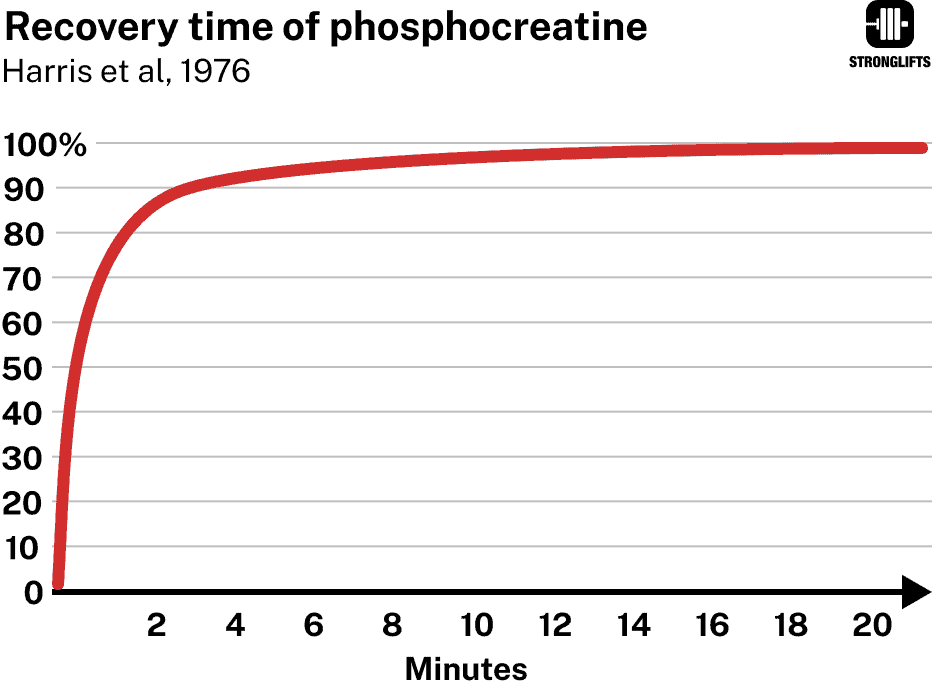
Your PCr energy stores are 12% more recovered after 2min rest, 16% more after 3min, and 20% more after 5min.
| Rest period | Recovery phosphocreatine (Harris, 1976) |
|---|---|
| 1min | 75% |
| 1min30 | 84% |
| 2min | 88% |
| 3min | 91% |
| 5min | 95% |
A study by Hernandez et al had 15 men Bench Press four sets with 85% of their max – about 92kg or 202lb (36). They were told to do as many reps as possible (AMRAP). One group rested 2min between sets. Another 5min. The last one 8min. Here’s how many reps each group completed…
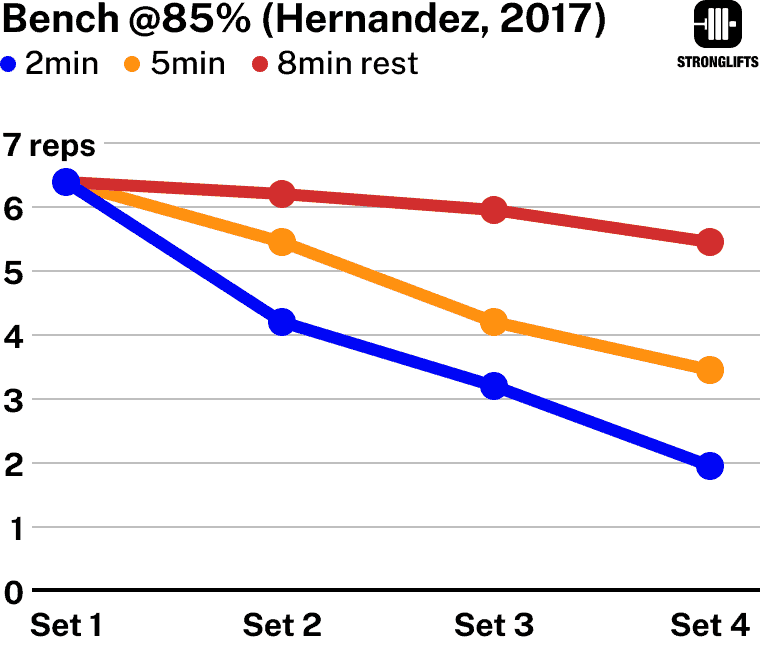
Resting 5min resulted in 23% more reps done than resting 2min. But resting 5min between every set would result in too long workouts. You can reduce your rest times by using top/back-off sets instead of straight sets. You then only need 2-3 min rest between most of your sets.
Read: 5×5 top/back-off sets for improving progress
Volume
Your training volume is the total amount of work you do. Doing enough volume is important for building strength and muscle. Let’s therefore review how much volume you do on Stronglifts 5×5 Intermediate.
Squat
The simplest way to calculate your volume is by counting the total weekly sets you do per exercise. We’ll use the Pause lifts variation of the program.
| Stronglifts 5×5 Intermediate | ||
|---|---|---|
| Workout A | Workout B | Workout C |
| Squat 5×5 | Deadlift 5×5 | Pause Squat 5×3 |
| Bench Press 5×5 | Incline Bench Press 5×8 | Pause Bench 5×3 |
| Barbell Rows 5×8 | Bench Press Feet up 5×8 | Pause Deadlift 2×3 |
| Assistance work | Assistance work | Assistance work |
You do five sets of Squats in workout A, and five sets of Pause Squats in workout C. That’s ten sets of Squats per week.
A study by Ralston et al defined ten sets per week per exercise as “high volume” (25). 5-9 sets is “medium volume”. 1-5 sets is “low volume”.

The Squat volume is high on Stronglifts 5×5 Intermediate.
Bench Press
You do four Bench Press exercises on Stronglifts 5×5 Intermediate.
| Stronglifts 5×5 Intermediate | ||
|---|---|---|
| Workout A | Workout B | Workout C |
| Squat 5×5 | Deadlift 5×5 | Pause Squat 5×3 |
| Bench Press 5×5 | Incline Bench Press 5×8 | Pause Bench 5×3 |
| Barbell Rows 5×8 | Bench Press Feet up 5×8 | Pause Deadlift 2×3 |
| Assistance work | Assistance work | Assistance work |
You do five sets of Bench Press in workout A, ten sets in workout B and five sets in workout C. That’s 20 sets per week or “high volume” according to the definition by Ralston et al (25).
If you think that’s too much, read the FAQ at the bottom.
Deadlift
You Deadlift twice a week on Stronglifts 5×5 Intermediate.
| Stronglifts 5×5 Intermediate | ||
|---|---|---|
| Workout A | Workout B | Workout C |
| Squat 5×5 | Deadlift 5×5 | Pause Squat 5×3 |
| Bench Press 5×5 | Incline Bench Press 5×8 | Pause Bench 5×3 |
| Barbell Rows 5×8 | Bench Press Feet up 5×8 | Pause Deadlift 2×3 |
| Assistance work | Assistance work | Assistance work |
You do five sets of Deadlifts in workout B, and two sets of Pause Deadlifts in workout C. That’s seven sets per week or “medium volume” according to the definition from Ralston et al (25).
If you think that’s not enough, read the FAQ at the bottom.
Upper vs lower body
On Stronglifts 5×5 Intermediate you do five exercises for your upper-body and four for your lower body. Bench and Rows work your upper body.
| Stronglifts 5×5 Intermediate | ||
|---|---|---|
| Workout A | Workout B | Workout C |
| Squat 5×5 | Deadlift 5×5 | Pause Squat 5×3 |
| Bench Press 5×5 | Incline Bench Press 5×8 | Pause Bench 5×3 |
| Barbell Rows 5×8 | Bench Press Feet up 5×8 | Pause Deadlift 2×3 |
| Assistance work | Assistance work | Assistance work |
Here’s the total volume you do on the three main lifts…
| Exercise | Sets | Volume |
|---|---|---|
| Squat | 10 | High |
| Bench | 20 | High |
| Deadlift | 7 | Medium |
If we add the five sets of Barbell Rows, we end up with 25 weekly sets for your upper body, and 17 weekly sets for your lower body.
| Body part | Exercises | Weekly sets |
|---|---|---|
| Upper | Bench, Row | 25 |
| Lower | Squat, Deadlift | 17 |
Stronglifts 5×5 Intermediate has therefore 60% volume for your upper-body, and 40% for your lower body.
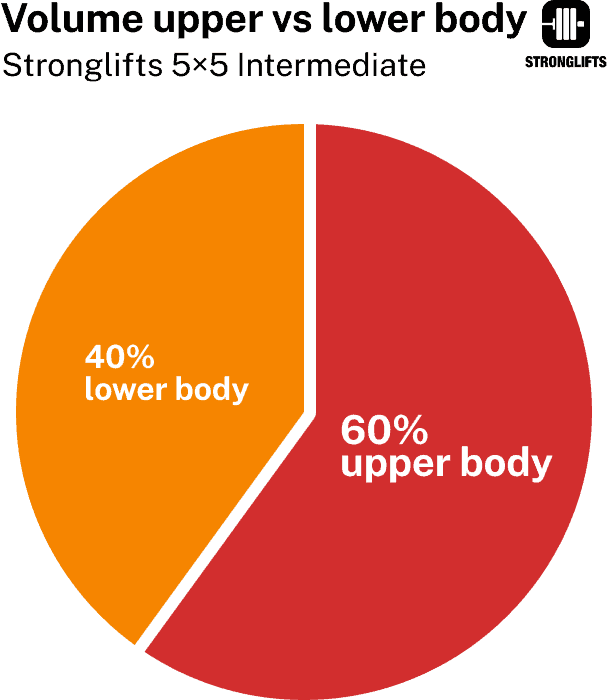
You can increase the volume for your upper-body further using assistance work as explained below.
Muscle Groups
Strength = skills × muscle (13, 14). Building muscle is important for getting stronger because bigger muscles can produce more force than smaller ones. So let’s look at how much volume you do for your major muscle groups.
First, a study by Schoenfeld et al defined ten sets per muscle group per week as “high volume” (27).
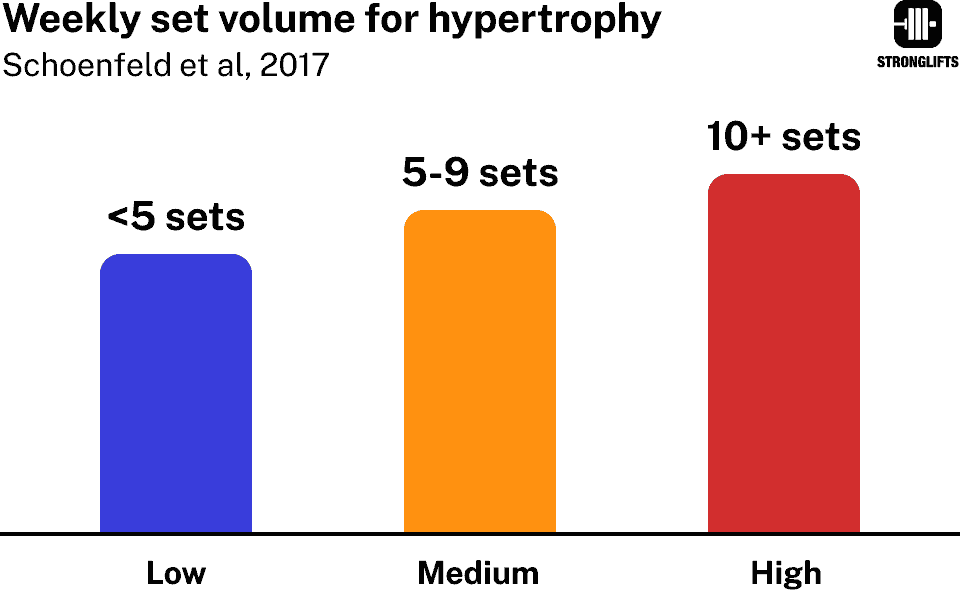
Note that low, medium and high volume all work for building muscle. New lifters typically don’t need much volume to progress. The more experienced you are, the more volume you’ll usually need to be doing.
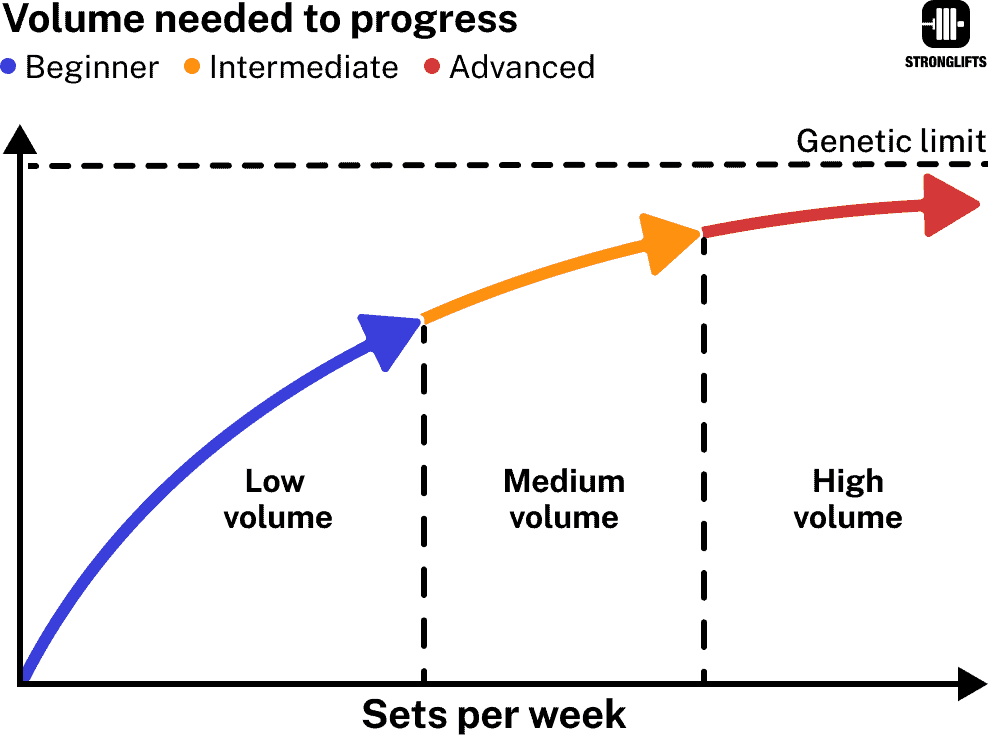
Quote from the study:
Clearly, substantial hypertrophic gains can be made using low volume protocols (≤4 weekly sets per muscle group). Such an approach therefore represents a viable muscle-building option for those who are pressed for time or those to which the conservation of energy is an ongoing concern (i.e., frail elderly).
Schoenfeld et al, 2017 (27).
If we count the weekly sets for the major muscle groups on Stronglifts 5×5 Intermediate, here’s the volume we get…
| Muscle | Exercise | Sets | Volume |
|---|---|---|---|
| Chest | Bench (flat, incline, feet up, pause) | 20 | High |
| Shoulders | Bench (flat, incline, feet up, pause) | 20 | High |
| Back | Barbell Row, Deadlift | 12 | High |
| Triceps | Bench (flat, incline, feet up, pause) | 20 | High |
| Biceps | Barbell Row | 5 | Medium |
| Legs | Squat, Deadlift | 17 | High |
Stronglifts 5×5 Intermediate is high volume for your chest, shoulders, back, legs and triceps. For biceps it’s medium volume. The biceps is one of the smallest muscle groups in your body. They have limited potential for growth. And so they shouldn’t get as much attention as they often do.
Nonetheless, if you want to do more work for your arms and have time for that, you can add assistance work.
Assistance Work
Assistance work is adding exercises to Stronglifts 5×5 Intermediate for smaller muscles like your biceps or abs. Example…
| Stronglifts 5×5 Intermediate | ||
|---|---|---|
| Workout A | Workout B | Workout C |
| Squat 5×5 | Deadlift 5×5 | Pause Squat 5×3 |
| Bench Press 5×5 | Incline Bench Press 5×8 | Pause Bench 5×3 |
| Barbell Rows 5×8 | Bench Press Feet up 5×8 | Pause Deadlift 2×3 |
| Barbell Curl 3×12 | Pullup 3×12 | Dips 3×12 |
| Hanging leg raise 3×12 | Dumbbell Curl 3×12 | Planks 3x30sec |
Here we’re adding one vertical pull movement (pullups) that works your back and biceps. We’re also adding two isolation exercises for your biceps. And we’re adding dips for chest and triceps, and two ab exercises.
We’re using higher reps because we already went heavy on the main lifts. The higher reps keep the weight lighter while creating more pump.
Here’s the volume now…
| Muscle | Exercise | Sets | Volume |
|---|---|---|---|
| Chest | Bench (flat, incline, feet up, pause) | 23 | High |
| Shoulders | Bench (flat, incline, feet up, pause) | 20 | High |
| Back | Barbell Row, Deadlift, Pullup | 15 | High |
| Triceps | Bench (flat, incline, feet up, pause), Dips | 23 | High |
| Biceps | Barbell Row, Barbell Curl, Pullup, DB curl | 14 | High |
| Legs | Squat, Deadlift | 17 | High |
The main drawback of adding assistance work is that it increases gym time. Say each set takes you 30 seconds to complete and you rest two minutes in between. That’s about 7min per exercise or 14 min per workout. This adds 45min of gym time per week or three hours per month.
What do you get for this? Contrary to popular belief doing double the volume doesn’t result in double the muscle gains. The study by Schoenfeld et al found that 10 sets per week resulted in about 36% more hypertrophy than five sets (27). More is better but you get diminishing returns.
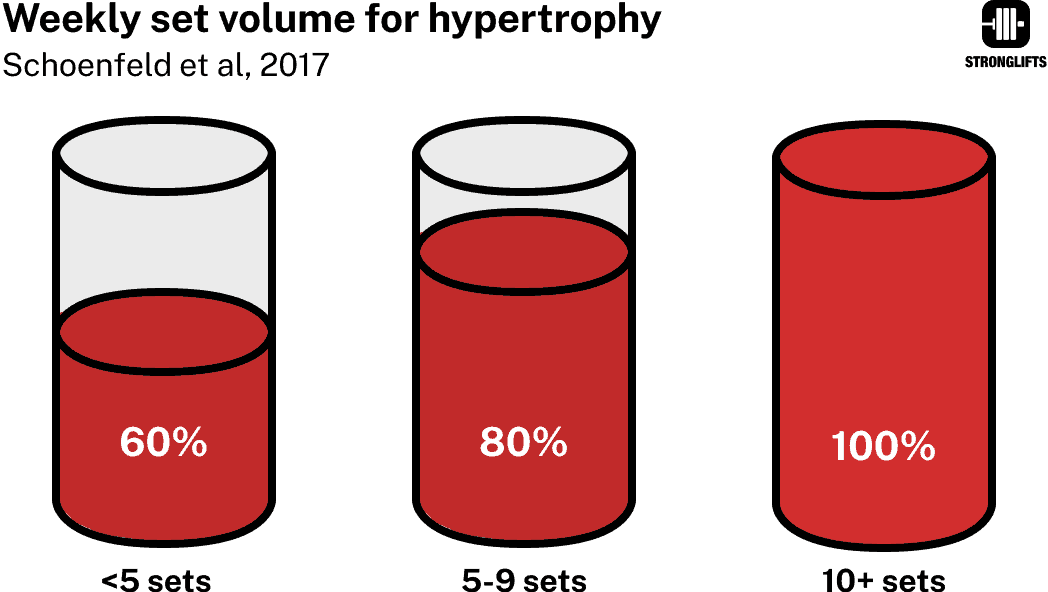
Some think suggesting assistance work means compound exercises don’t work small muscles like the arms. But that’s not the case. Several studies have compared doing compounds only vs compounds plus isolation exercises for arms (38, 39, 40, 41). These studies show that your arms always get bigger with compounds. They don’t stay small.
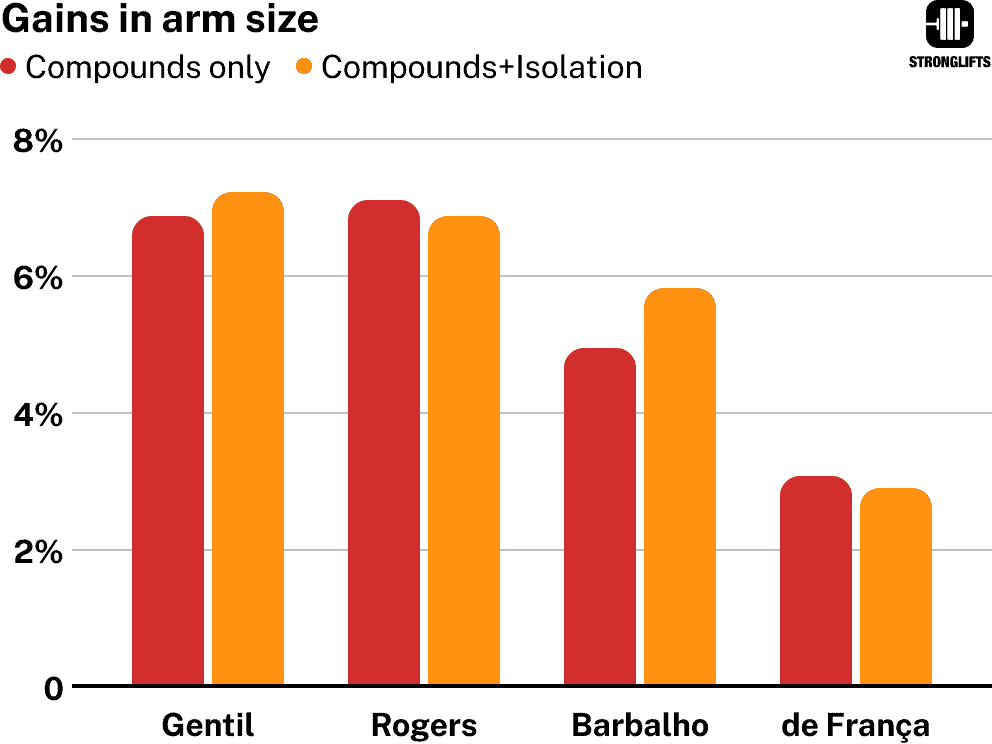
Adding isolation exercises for arms usually makes little to no difference in arm size – if you’re training the compound lifts hard and heavy. If you don’t, then you’ll have to make up for the lower intensity by doing more volume.
In fact, the people who train the big lifts hard usually don’t have the time or energy to do more than three exercises per workout. They’re happy with their arm size anyway. The ones who don’t train the big lifts hard usually need to do more assistance work. They often don’t understand how the stronger lifters have bigger arms despite barely doing direct arm work.
If you like training your arms, if you like feeling the pump, if you have time to do more, then feel free to add assistance work. If you’re limited on time, then don’t feel forced to do assistance work. Your arms won’t stay small if you do the big lifts only. Compound lifts work your whole body.
The Stronglifts app has Assistance Work options. Download the app, then go to program – Stronglifts 5×5 Intermediate – select your program variation – add assistance work. Everything will be setup for you. You can easily customize exercises if you want.
Frequently asked questions
When should you switch from Stronglifts 5×5 to Stronglifts 5×5 Intermediate?
Switch to Stronglifts 5×5 Intermediate when you’re no longer making progress on Stronglifts 5×5. You can also switch to get a change of pace if you’re getting bored of doing the same two workouts and exercises.

How much should you lift before switching to Stronglifts 5×5 Intermediate?
Impossible to say. Different people will progress at different rates because progress is influenced by multiple factors.
As a rule of thumb, if your Squat has been stuck at the same weight for a month, despite good nutrition, recovery, technique and effort, then make the switch. If Squatting 3x/week has become too hard, then make the switch. If you’re bored and want a change, then make the switch.
A common concern is not wanting to switch too soon. But any gains you could have made on Stronglifts 5×5, you can make on Stronglifts 5×5 Intermediate. The progression is a little slower and the program is more complex. But both programs revolve around the same principles of compound lifts and progressive overload. That’s what drives most of the progress.
You can easily switch from Stronglifts 5×5 to Stronglifts 5×5 Intermediate in the Stronglifts app. Go to program – select Stronglifts 5×5 Intermediate. Your starting weights will be calculated based on your recent lifts on Stronglifts 5×5.
Which variation of Stronglifts 5×5 Intermediate should you start with?
Pick the variation that you think will help you most based on your needs and preferences. If you’re not sure which one to pick, then start with the pause lifts variation of Stronglifts 5×5 Intermediate.
| Stronglifts 5×5 Intermediate | ||
|---|---|---|
| Workout A | Workout B | Workout C |
| Squat 5×5 | Deadlift 5×5 | Pause Squat 5×3 |
| Bench Press 5×5 | Incline Bench Press 5×8 | Pause Bench 5×3 |
| Barbell Rows 5×8 | Bench Press Feet up 5×8 | Pause Deadlift 2×3 |
| Assistance work | Assistance work | Assistance work |
The pause lifts in workout C will strengthen the bottom of your Squat and Bench. These are the hardest part of the movement. You’ll also learn to keep the bar in contact with your legs with the Pause Deadlifts. You already know these exercises but only need to add a pause. This makes the transition from Stronglifts 5×5 easier compared to the other program variations.
The Stronglifts app has the Pause lifts variation made for you. Download the app, then go to program – select Stronglifts 5×5 Intermediate – select Pause Lifts. Everything will be setup for you.
Should you do straight sets or top/back-off sets?
Best is to use top/back-off sets. Stronglifts 5×5 Intermediate is for lifters who are past the easy beginner gains. Your progress is slower now. And so top/back-off sets make more sense. This means…
- 5×5: one heavy set of five reps, then 4×5 with 10% less weight
- 5×8: one heavy set of eight reps, then 4×8 with 10% less weight
- 5×3: one heavy set of three reps, then 4×3 with 10% less weight
Read: 5×5 top/back-off sets for improving progress.
Why only two Deadlift sets in workout C?
Workout C would take too long otherwise.
Workout C is an SBD day like in powerlifting competitions. You Squat, Bench and Deadlift in the same workout. You Squat and Deadlift more weight than you Bench. You typically rest longer between sets on these lifts. You do more warmup sets. SBD workouts tend to be longer, and more demanding. This is especially the case now that you’re lifting much heavier weights than on Stronglifts 5×5 (or you wouldn’t be doing this program).
Doing only two sets of Deadlifts limits the length of workout C. It makes it less challenging. You can do more sets if you want. But you’re already doing five sets of Deadlifts in workout B. So you have plenty of volume to progress.
Are seven sets of Deadlifts per week enough?
If you think you need ten sets to progress, then feel free to do more. If you haven’t started the program yet, then try seven sets first. It works fine in my experience. It also leaves room to add sets later if you do get stuck.
Less experienced lifters often fall into the “more-is-better” trap. They hear more volume is better and think that means low and medium volume doesn’t work. Or they think doing 10 sets instead of 5 sets means you gain twice the strength. The study from Ralston et al tells otherwise (24). Quote…
Medium (MWS) or high weekly set (HWS) strength training is marginally more effective in producing strength gains than low weekly set (LWS) strength training.
Ralston et al, 2017 (24)
More is better – but only a little bit better. Most of the strength gains come from doing the first sets. Every additional set you do results in smaller extra gains. You get diminishing returns for your efforts.
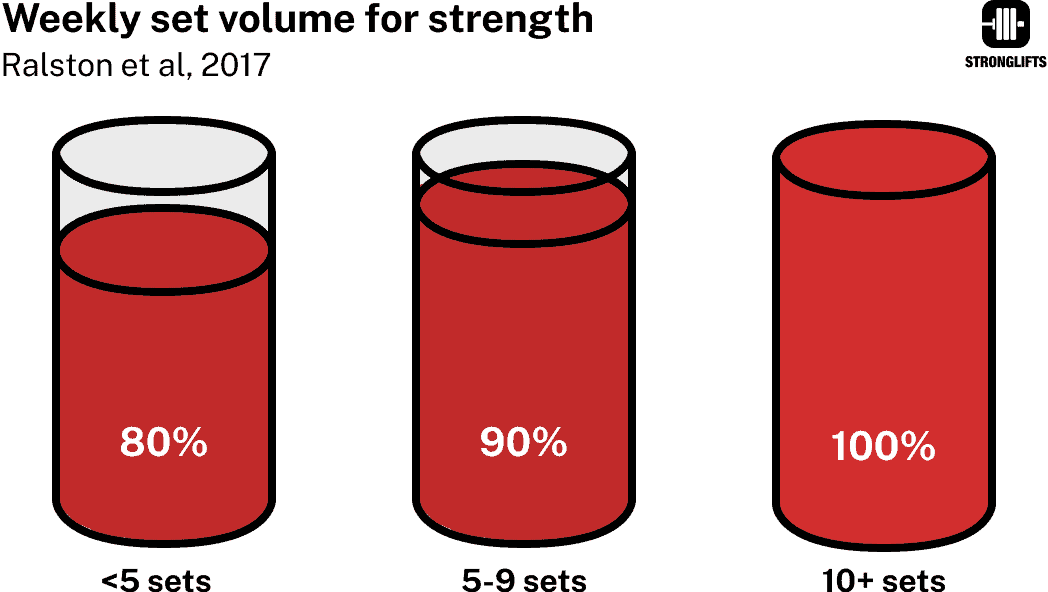
It’s important to keep the context in mind. You’re doing seven sets on Deadlifts PLUS ten sets on Squats AND five sets on Barbell Rows. The first two lifts work your legs. All three work your lower back. Stronger legs from Squats help to increase your Deadlifts. The strength gains carry over.
If you try five sets of Deadlifts in workout C, you’ll probably skip some sets after a while. Doing five sets of Squats, five sets of Bench Press, and then five sets of Deadlifts is a long and hard workout. And again, it’s not like doing three extra sets is suddenly going to double your Deadlift.
Isn’t 3x/week Bench Press too much?
If you think it’s too much, then feel free to substitute one of the Bench slots by an Overhead Press, like in the Alternate Lifts program variation.
In my training and coaching experience, 3x/week Bench Press doesn’t cause issues. It increases your Bench Press by giving you more technical practice. It distributes the volume over more workouts. You can go harder in each session compared to doing all your Bench volume on the same day.
A study by Travis et al analyzed 364 powerlifters (6). The average male lifter trained the Bench 2.7x/week. Yet powerlifting has a much lower risk of injury than most sports, including swimming (42, 43, 44).
Using exercise variations on the Bench Press further lowers the risk of injury by loading your joints differently (45). You’re alternating heavier and lighter sessions with lower and higher reps. You’re doing enough volume for your chest and shoulders which removes the need for assistance work.
Isn’t 20 sets per week on Bench too much?
If you think it’s too much, do less. Substitute one of the Bench Press slots by an Overhead Press, like in the Alternate Lifts program variation. If you’ve never done 20 sets per week for the Bench Press, give it a try. It doesn’t cause issues in my training and coaching experience.
20 sets per week on the Bench Press may seem like a lot when you compare that to the ten sets you do on Squats and the seven sets on Deadlifts.
| Exercise | Sets | Volume |
|---|---|---|
| Squat | 10 | High |
| Bench | 20 | High |
| Deadlift | 7 | Medium |
But the Squat and Deadlift mostly work your lower body while the Bench Press mostly works your upper body. The three main lifts therefore give you 17 sets for your lower body vs 20 sets for your upper-body (excluding rows).
| Exercise | Exercise | Weekly sets |
|---|---|---|
| Upper body | Bench Press | 20 |
| Lower body | Squat, Deadlift | 17 |
If you only did 10 sets for the Bench, you’d be doing 17 sets for legs vs 10 sets for chest, shoulders and triceps. Doing 20 sets for the Bench results in a more even amount of work for your lower and upper body.
Here’s another way to think about it: the Bench Press works smaller muscles than the Squat and Deadlift. It works less muscles too. The weight you lift is therefore lighter on the Bench Press.
A study by Ball et al analyzed the competition results of 47,913 powerlifters (37). Here’s the average Squat/Deadlift to Bench ratio that they found…
| Ball et al, 2016 | Men | Women |
|---|---|---|
| Squat to Bench ratio | 1.52 | 1.7 |
| Deadlift to Bench ratio | 1.75 | 2.19 |
Say you Bench Press 200lb, Squat 300lb and Deadlift 350lb. You do 5×5 on all three lifts. Volume = set × rep × weight. Your volume on the Bench is lower because the weight is lighter than on the Deadlift.
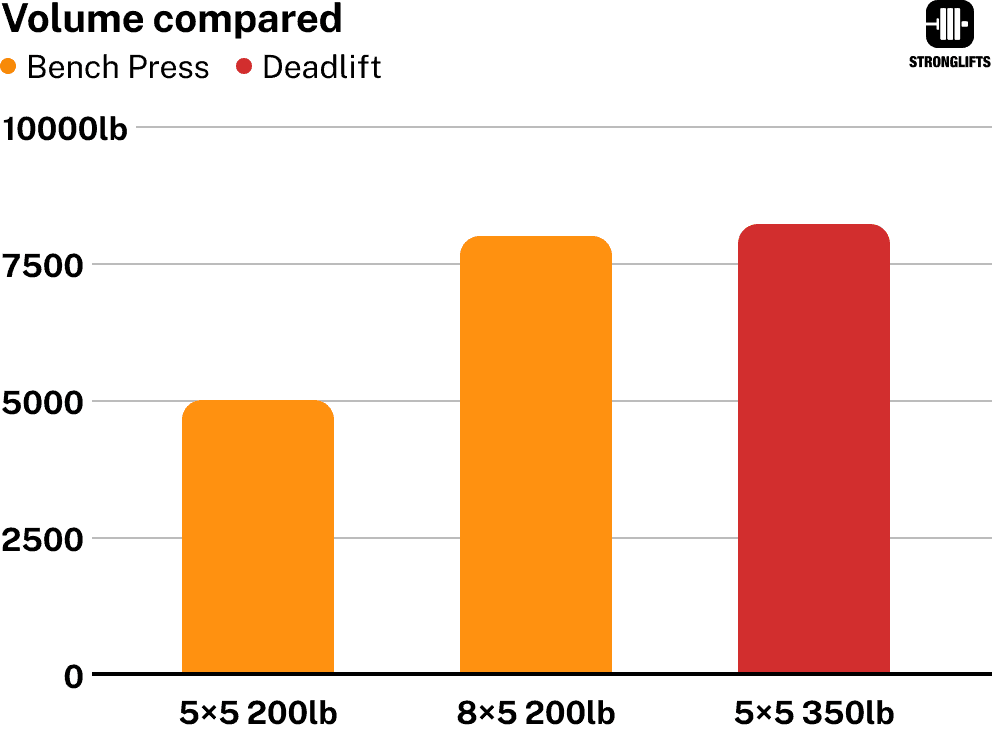
You could therefore argue that five hard sets on the Deadlift equals 6-7 sets on the Bench Press. You can handle more sets on the Bench Press because it works smaller and less muscles, and the weight is lighter.
Shouldn’t you do a 1:1 ratio Bench, Overhead Press and Row?
No.
First, it’s impractical. 3x/week Bench, 2x/week Squat and 2x/week Deadlift is eight exercises per week. If you add 3x Overhead Press and 3x Barbell Row to achieve a 1:1 ratio with the Bench Press, you’d have to do 14 exercises per week. That’s almost five exercises 3x/week. Your workouts will either be too long and tiring, or you’ll have to train 5x/week. It’s too much.
Say you do that anyway. You’re now doing 20 sets for Bench plus 20 sets for Overhead Press. That’s 40 sets for your shoulders per week. That’s too much volume for most people. It can result in achy shoulders – the opposite of what you’re probably trying to achieve by going for a 1:1 ratio. You could fix that by doing each lift only once or twice a week. But then you’re not doing enough volume on your Bench Press to progress.
Two, studies show that most people are naturally stronger at pushing than pulling (46, 47). So the advice of having a 1:1 push-pull strength ratio doesn’t seem realistic. It’s true that many gym goers focus too much on the “mirror muscles” like the chest and shoulders while neglecting the back of their body. But this is not a problem on Stronglifts 5×5 Intermediate. You’re doing Barbell Rows every week in workout A.
If your shoulders feel better if you do more Overhead Press and Rows, feel free to add it as Assistance Work. For example, you could do 3×12 Dumbbell Overhead Press at the end of one of the workouts, and 3×12 Face Pulls at the end of another workout. But it’s unnecessary and impractical to do the exact same amount of sets for all three movements.
Is there a spreadsheet for Stronglifts 5×5 Intermediate?
Yes, just go to Stronglifts 5×5 Intermediate spreadsheet.
The spreadsheet is great for getting a big picture overview of how the program works, and how your weights will progress. But for logging your workouts in the gym, use the Stronglifts app. It’s easier to use, does all the math for you, and has lots of extra features like a built-in rest timer.
Join the Stronglifts community to get free access to all the spreadsheets for every Stronglifts program. You’ll also get daily email tips to stay motivated. Enter your email below to sign up today for free.
References
1. Kraemer, William J, and Nicholas A Ratamess. “Fundamentals of resistance training: progression and exercise prescription.” Medicine and science in sports and exercise vol. 36,4 (2004): 674-88.
2. Fonseca, Rodrigo M et al. “Changes in exercises are more effective than in loading schemes to improve muscle strength.” Journal of strength and conditioning research vol. 28,11 (2014): 3085-92.
3. Latella, Christopher et al. “Long-Term Strength Adaptation: A 15-Year Analysis of Powerlifting Athletes.” Journal of strength and conditioning research vol. 34,9 (2020): 2412-2418.
4. Openpowerlifting. “Michael Tuchscherer.” Powerlifting Rankings, www.openpowerlifting.org/u/michaeltuchscherer.
5. Tuchscherer, M. “The Reactive Training Manual: Developing Your Own Custom Training Program for Powerlifting“. Reactive Training Systems. 2008.
6. Travis, S Kyle et al. “Characterizing the Tapering Practices of United States and Canadian Raw Powerlifters.” Journal of strength and conditioning research vol. 35,Suppl 2 (2021): S26-S35.
7. McLaughlin, Thomas M. Bench Press More Now : Breakthroughs in Biomechanics and Training Methods. 1984.
8. Madsen, N, and T McLaughlin. “Kinematic factors influencing performance and injury risk in the bench press exercise.” Medicine and science in sports and exercise vol. 16,4 (1984): 376-81.
9. McLaughlin, Thomas M., and Nels H. Madsen. “Bench Press: Bench press techniques of elite heavyweight powerlifters.” Strength & Conditioning Journal 6.4 (1984): 44-44.
10. Rodríguez-Ridao, David et al. “Effect of Five Bench Inclinations on the Electromyographic Activity of the Pectoralis Major, Anterior Deltoid, and Triceps Brachii during the Bench Press Exercise.” International journal of environmental research and public health vol. 17,19 7339. 8 Oct. 2020.
11. Saeterbakken, Atle Hole et al. “The Effects of Bench Press Variations in Competitive Athletes on Muscle Activity and Performance.” Journal of human kinetics vol. 57 61-71. 22 Jun. 2017
12. Muyor, José M et al. “Evaluation and comparison of electromyographic activity in bench press with feet on the ground and active hip flexion.” PloS one vol. 14,6 e0218209. 14 Jun. 2019.
13. Taber, Christopher B et al. “Exercise-Induced Myofibrillar Hypertrophy is a Contributory Cause of Gains in Muscle Strength.” Sports medicine (Auckland, N.Z.) vol. 49,7 (2019): 993-997.
14. Mattocks, Kevin T et al. “Practicing the Test Produces Strength Equivalent to Higher Volume Training.” Medicine and science in sports and exercise vol. 49,9 (2017): 1945-1954.
15. Halperin, Israel, et al. “Autonomy: A Missing Ingredient of a Successful Program?” Strength & Conditioning Journal, vol. 40, no. 4, 2018, pp. 18-25.
16. American College of Sports Medicine. “American College of Sports Medicine position stand. Progression models in resistance training for healthy adults.” Medicine and science in sports and exercise vol. 41,3 (2009): 687-708.
17. Hales, Michael E et al. “Kinematic analysis of the powerlifting style squat and the conventional deadlift during competition: is there a cross-over effect between lifts?.” Journal of strength and conditioning research vol. 23,9 (2009): 2574-80.
18. McLaughlin, T M et al. “A kinematic model of performance in the parallel squat by champion powerlifers.” Medicine and science in sports vol. 9,2 (1977): 128-33.
19. Kompf, Justin, and Ognjen Arandjelović. “The Sticking Point in the Bench Press, the Squat, and the Deadlift: Similarities and Differences, and Their Significance for Research and Practice.” Sports medicine (Auckland, N.Z.) vol. 47,4 (2017): 631-640.
20. Miletello, Wendy M et al. “A biomechanical analysis of the squat between competitive collegiate, competitive high school, and novice powerlifters.” Journal of strength and conditioning research vol. 23,5 (2009): 1611-7.
21. Swinton, Paul A et al. “A biomechanical analysis of straight and hexagonal barbell deadlifts using submaximal loads.” Journal of strength and conditioning research vol. 25,7 (2011): 2000-9.
22. McLaughlin, T M et al. “Bench Press: Bench Press Techniques of Elite Heavyweight Powerlifters.” National Strength and Conditioning Association Journal, vol. 6, no. 4, August 1984, pp. 44-44.
23. Howe, Louis, and Mark Waldron. “Advanced Resistance Training Strategies for Increasing Muscle Hypertrophy and Maximal Strength Part 2: Intensification Methods.” Strength and Conditioning Journal, 2018.
24. Ralston, Grant W et al. “The Effect of Weekly Set Volume on Strength Gain: A Meta-Analysis.” Sports medicine (Auckland, N.Z.) vol. 47,12 (2017): 2585-2601.
25. Schoenfeld, Brad J et al. “Dose-response relationship between weekly resistance training volume and increases in muscle mass: A systematic review and meta-analysis.” Journal of sports sciences vol. 35,11 (2017): 1073-1082.
26. Nigro, Federico, and Sandro Bartolomei. “A Comparison Between the Squat and the Deadlift for Lower Body Strength and Power Training.” Journal of human kinetics vol. 73 145-152. 21 Jul. 2020
27. Schoenfeld, Brad J et al. “Effects of different volume-equated resistance training loading strategies on muscular adaptations in well-trained men.” Journal of strength and conditioning research vol. 28,10 (2014): 2909-18.
28. Campos, Gerson E R et al. “Muscular adaptations in response to three different resistance-training regimens: specificity of repetition maximum training zones.” European journal of applied physiology vol. 88,1-2 (2002): 50-60.
29. Kubo, Keitaro et al. “Effects of 4, 8, and 12 Repetition Maximum Resistance Training Protocols on Muscle Volume and Strength.” Journal of strength and conditioning research vol. 35,4 (2021): 879-885.
30. Mangine, Gerald T et al. “The effect of training volume and intensity on improvements in muscular strength and size in resistance-trained men.” Physiological reports vol. 3,8 (2015): e12472.
31. Goldberg, A L et al. “Mechanism of work-induced hypertrophy of skeletal muscle.” Medicine and science in sports vol. 7,3 (1975): 185-98.
32. Schoenfeld, Brad J. “The mechanisms of muscle hypertrophy and their application to resistance training.” Journal of strength and conditioning research vol. 24,10 (2010): 2857-72.
33. Lopez, Pedro et al. “Resistance Training Load Effects on Muscle Hypertrophy and Strength Gain: Systematic Review and Network Meta-analysis.” Medicine and science in sports and exercise vol. 53,6 (2021): 1206-1216.
34. Starr, Bill. The Strongest Shall Survive: Strength Training for Football. Fitness Consultants and Supply, 1976.
35. Harris, R C et al. “The time course of phosphorylcreatine resynthesis during recovery of the quadriceps muscle in man.” Pflugers Archiv : European journal of physiology vol. 367,2 (1976): 137-42.
36.Hernandez, Dennis J et al. “Effect of Rest Interval Duration on the Volume Completed During a High-Intensity Bench Press Exercise.” Journal of strength and conditioning research vol. 35,11 (2021): 2981-2987.
37. Ball, Robert, and Drew Weidman. “Analysis of USA Powerlifting Federation Data From January 1, 2012-June 11, 2016.” Journal of strength and conditioning research vol. 32,7 (2018): 1843-1851.
38. Gentil, Paulo et al. “Effect of adding single-joint exercises to a multi-joint exercise resistance-training program on strength and hypertrophy in untrained subjects.” Applied physiology, nutrition, and metabolism = Physiologie appliquee, nutrition et metabolisme vol. 38,3 (2013): 341-4.
39. Barbalho, Matheus et al. “Does the addition of single joint exercises to a resistance training program improve changes in performance and anthropometric measures in untrained men?.” European journal of translational myology vol. 28,4 7827. 2 Nov. 2018
40. de França, Henrique Silvestre et al. “The effects of adding single-joint exercises to a multi-joint exercise resistance training program on upper body muscle strength and size in trained men.” Applied physiology, nutrition, and metabolism = Physiologie appliquee, nutrition et metabolisme vol. 40,8 (2015): 822-6.
41. Rogers, R. A., et al. “The effect of supplemental isolated weight-training exercises on upper-arm size and upper-body strength.” NSCA Conference. 2000.
42. Keogh, Justin W L, and Paul W Winwood. “The Epidemiology of Injuries Across the Weight-Training Sports.” Sports medicine (Auckland, N.Z.) vol. 47,3 (2017): 479-501.
43. Raske, Ase, and Rolf Norlin. “Injury incidence and prevalence among elite weight and power lifters.” The American journal of sports medicine vol. 30,2 (2002): 248-56.
44. Siewe, J et al. “Injuries and overuse syndromes in powerlifting.” International journal of sports medicine vol. 32,9 (2011): 703-11.
45. Saeterbakken, Atle Hole et al. “The Effects of Bench Press Variations in Competitive Athletes on Muscle Activity and Performance.” Journal of human kinetics vol. 57 61-71. 22 Jun. 2017
46. Negrete, Rodney J et al. “Upper body push and pull strength ratio in recreationally active adults.” International journal of sports physical therapy vol. 8,2 (2013): 138-44.
47. Pearson, Simon N et al. “Kinematics and kinetics of the bench-press and bench-pull exercises in a strength-trained sporting population.” Sports biomechanics vol. 8,3 (2009): 245-54.




